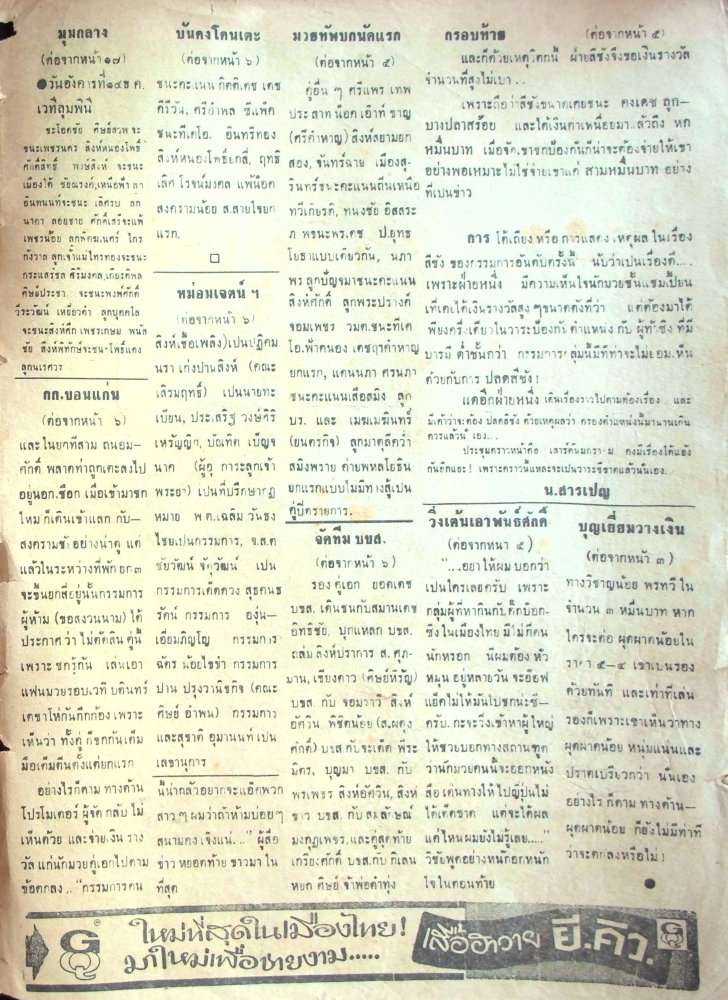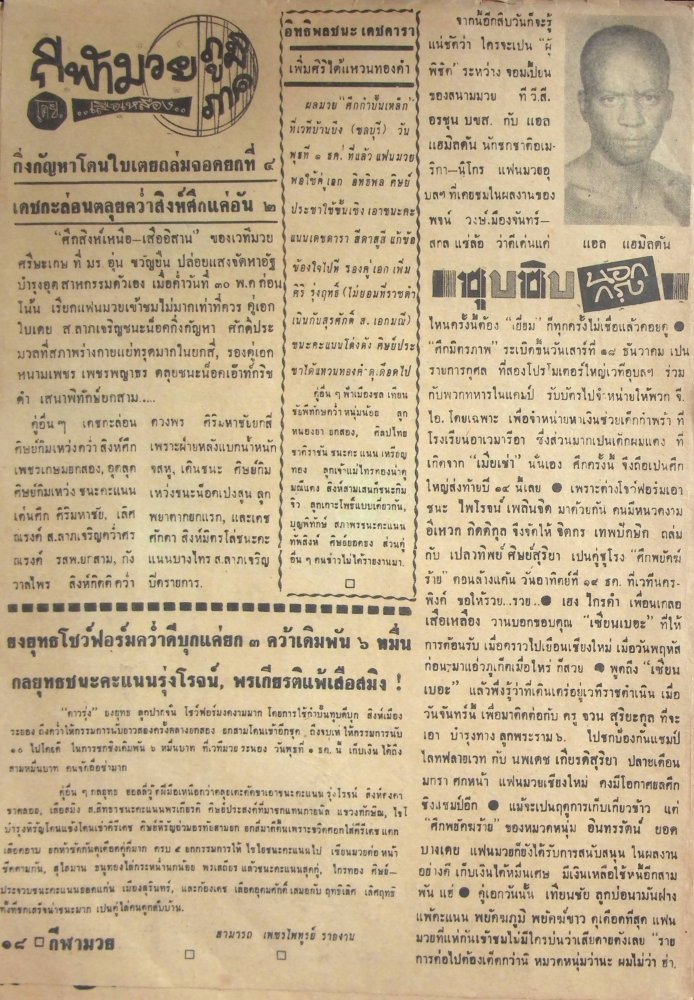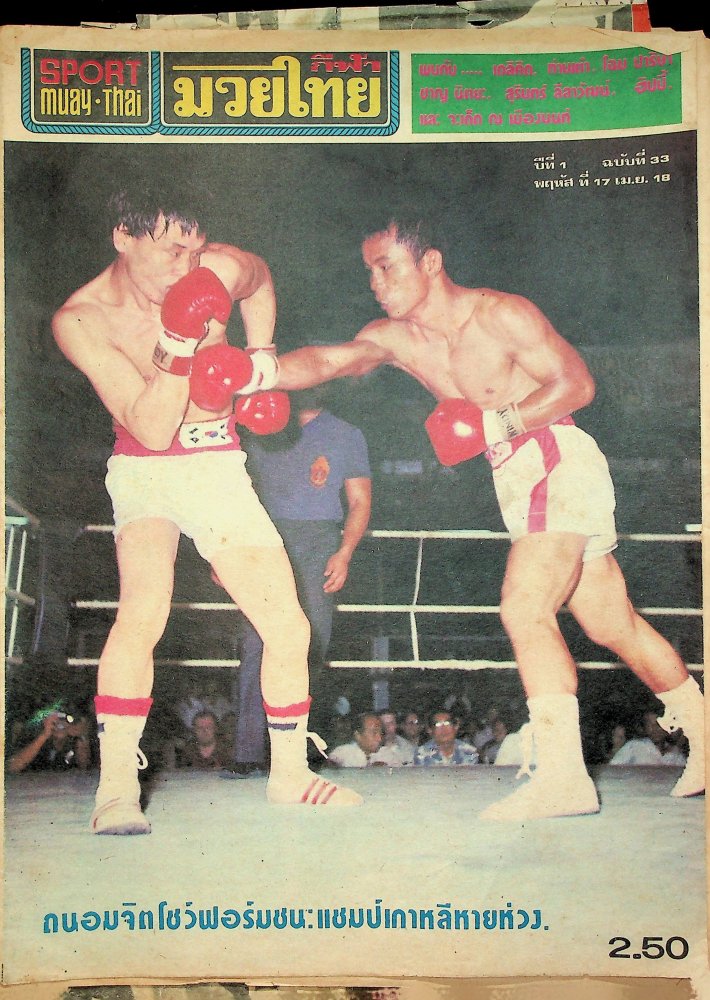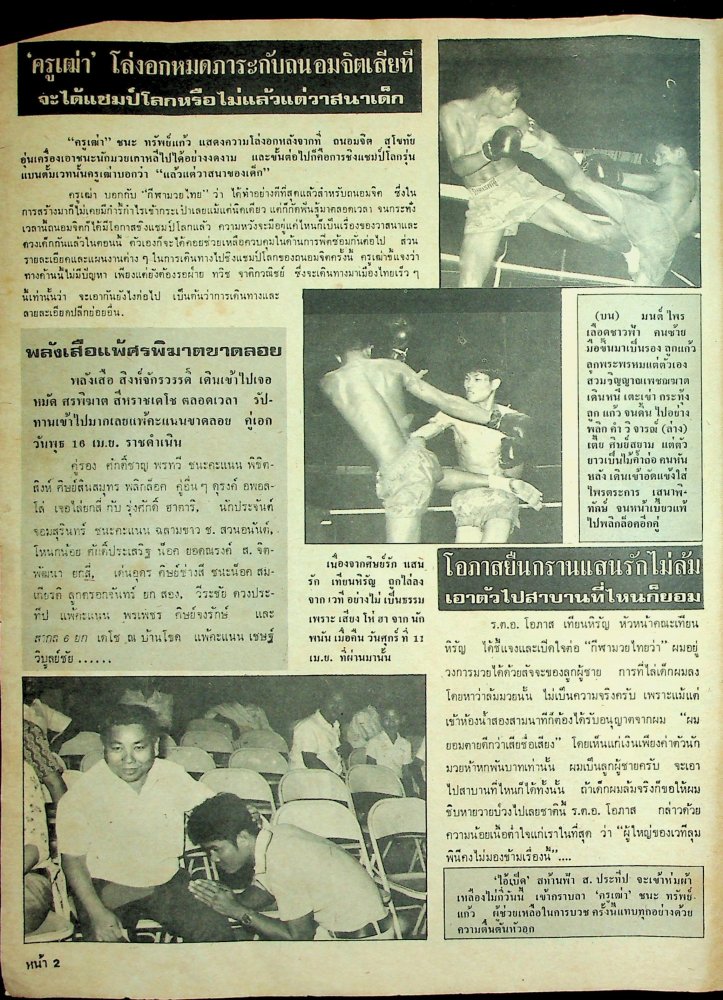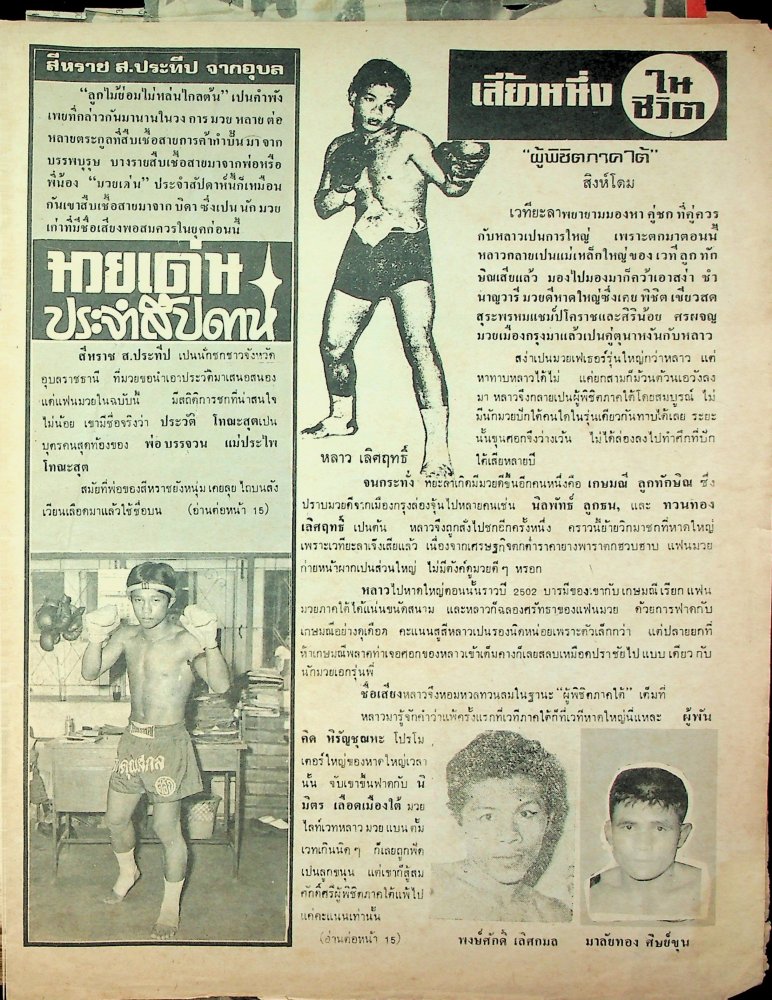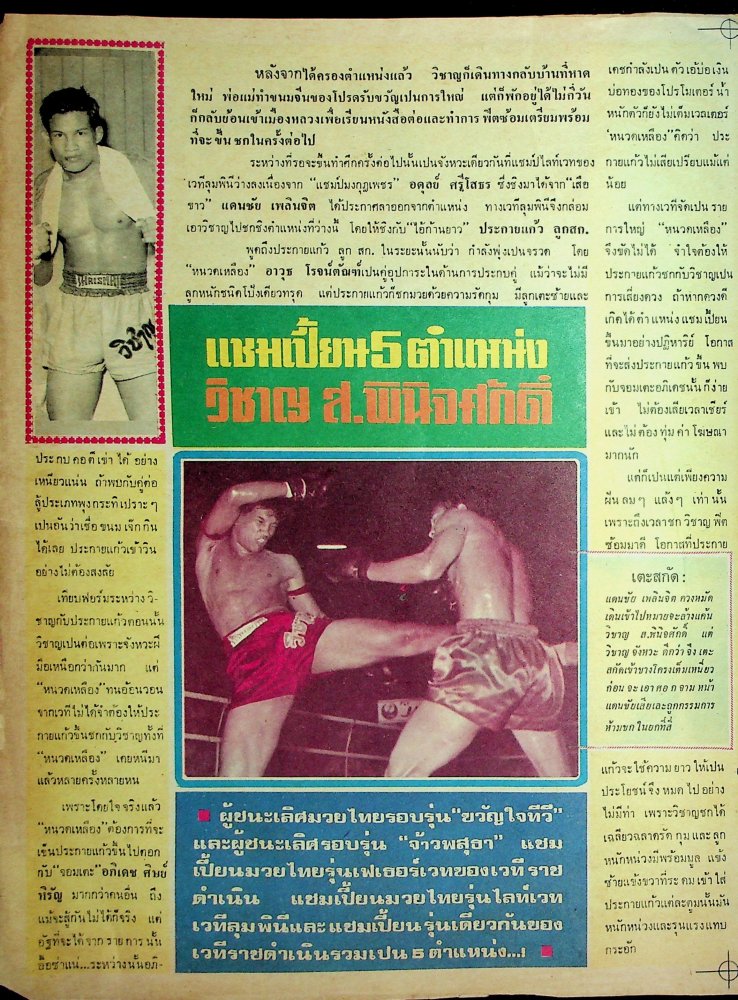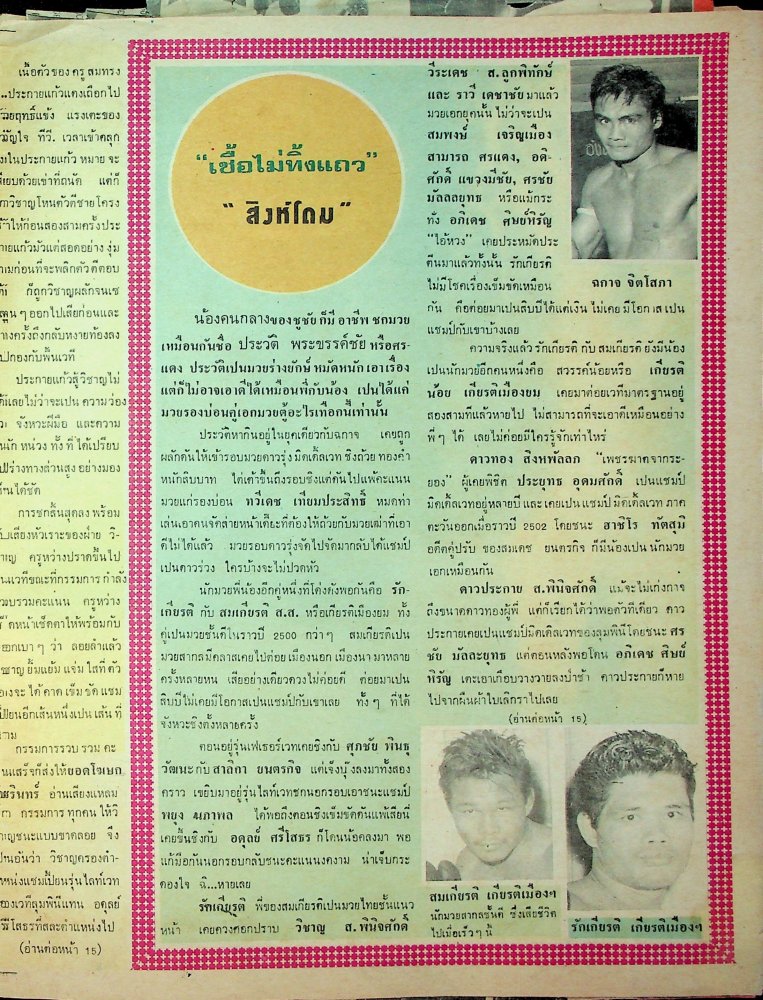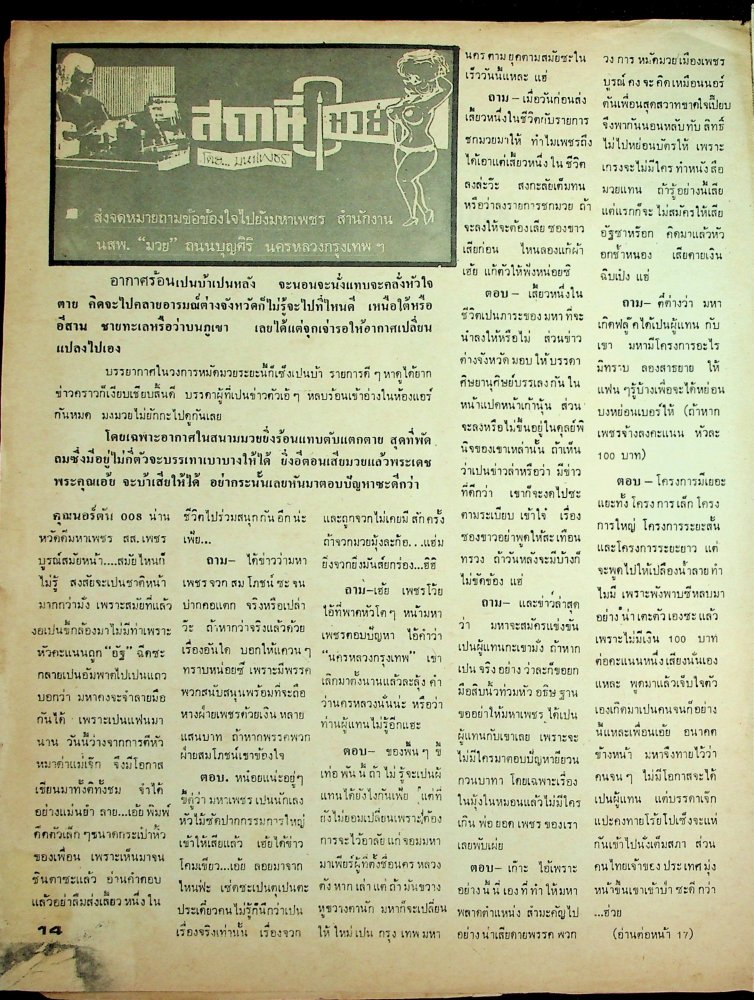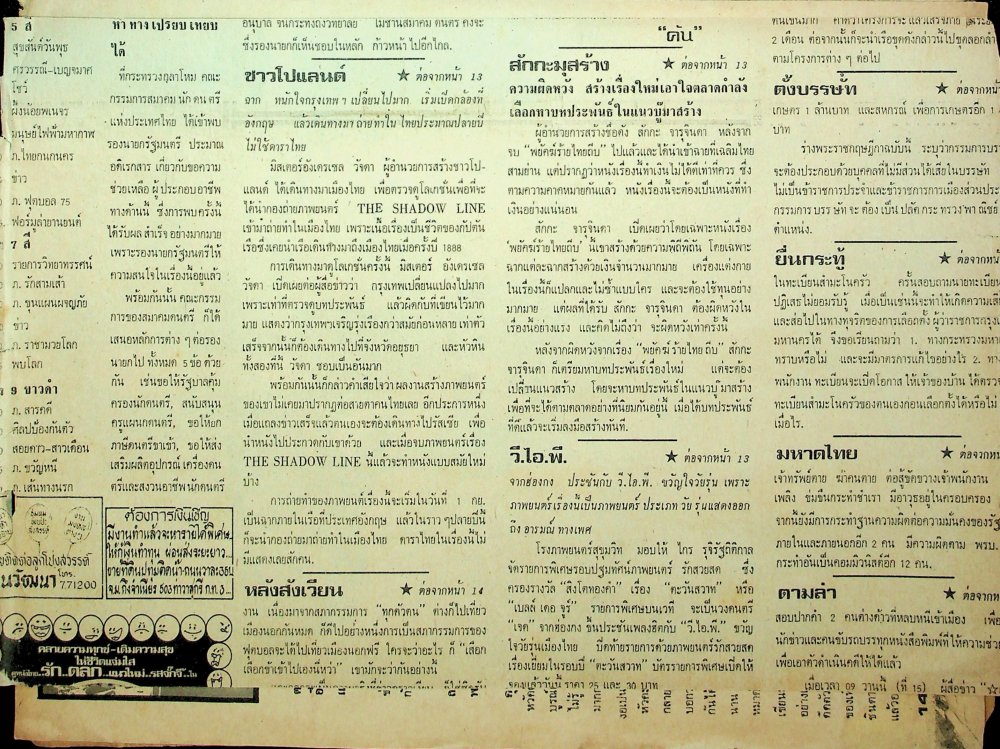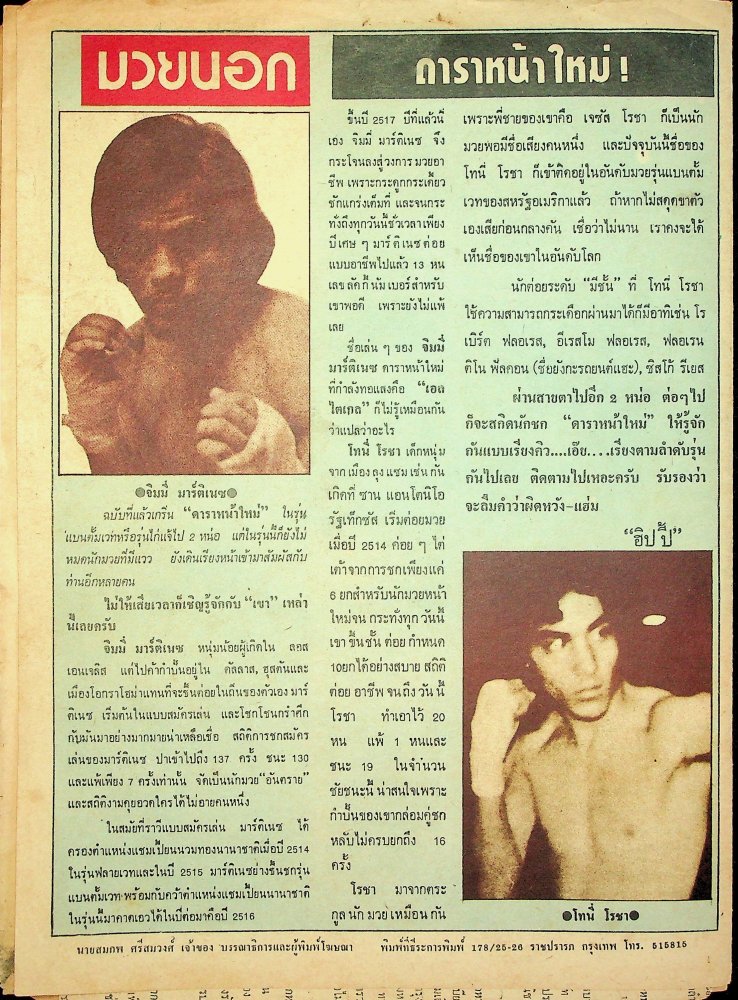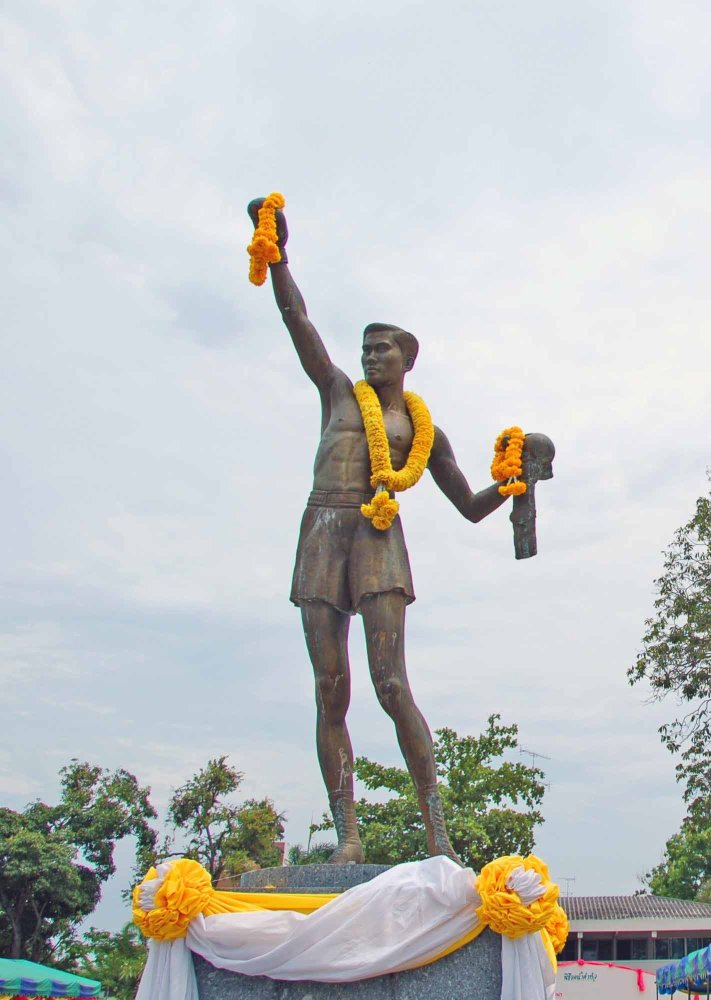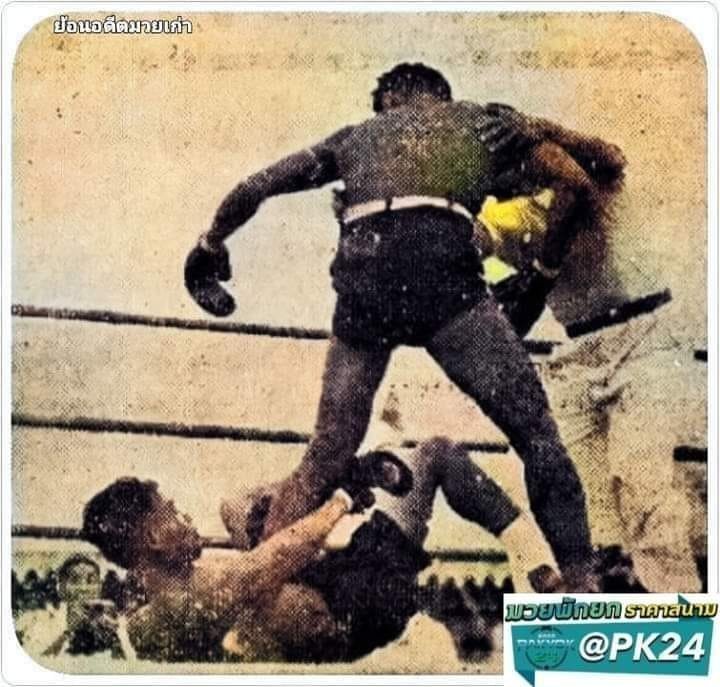-
Posts
2,165 -
Joined
-
Days Won
490
Everything posted by Kevin von Duuglas-Ittu
-
Parallel Aesthetics In the West: 1980s Mike Tyson In showing the way in which dynamic color photography in magazines in boxing can co-exist in American representations, along with fine art black and white photography, here are photographs of Mike Tyson in 1986 (Sports Illustrated, inside pages) and in 1988 by the fine art photographer Albert Watson. These are in the same years as the early Muay Thai magazines filled with newsprint black and whites, behind color covers at the top of this post. The image styles, depicting the exploits of an urban kid (above training in the Catskills), Mike becoming the youngest Heavyweight world champion in history do not conflict. He is simultaneously embraced by a big, glossing color National Magazine, and also raised up as a subject of fine art black and white, expressing a classical beauty.
-
This thread was inspired by the opportunity think about my new experiment with Deep Black stylistics in Muay Thai portraiture, and much of what followed was my reflection on likely influences, things at play in own own aesthetic choices and the basic techniques I'm using in capture. I want to understand more richly what I'm doing, but also to see why it works, because the images are somewhat startling to me, more than a sum of their parts. Something is happening within them that I can only describe as my sensation that "the camera sees". It sees things that are there, but are often just flitting, as dim reflections of powerful truths. As I edit portraits dimension of personality and character constantly are morphing in varying signatures. In this case, I'm just very, very surprised, recognizing on the faces something I feel in them when in their presence, but something impossible to put words to...but the thread is also about my struggle with black and white photography in Thailand, and feeling my way through mixed ambitions in representing the art. And, these particularly styled photographs, due to being so very dark, and the possible difficulties in their reception, make those long waiting concerns come to the surface even more. They are part of this photographic style. They cannot be separated from them, and in this way address the ways in which I believe that black and white photography (at least to the West) opens doors of rich value, an honoring of a sport and art that is not their own, which points us back into our own history, our own traditions, our own past...but also, Thailand's Muay Thai, because of its Buddhism, cuts through several Western problematics, especially those concerning our relationship to violence, the more reckless affects involving loss of control, and how that relates to entertainment values, and social values, and masculinity itself. And for me, some of this truth is found in the eyes.
-
The Reading of Color In the History of the Sport In particular to Muay Thai, these shots of a 1986 Muay Thai magazine help illustrate some of why black and white photographs are not well regarded. 1986 is when the Golden Age really started pumping. The economy was booming and Bangkok full of burgeoning growth. Peoples poured in from the provinces to find work in the surging modernity, and many became gambling fans in the National Stadium, cheering on fighters from their provinces. The provinces were shining on the big national stage, with their fighting heros at Rajadamnern and Lumpinee. This was an extraordinary time in Thailand's history, and the meaningfulness of Muay Thai as a symbol for the nation, but also in terms of regional identities. These new urban fans bought these magazines, they were the primary mode of following the Capital sport, as National broadcast television did not yet exist. But, you can see the quite stark contrast between the expensively printed cover in color, and the newsprint images inside. - Sylvie collects and studies old Muay Thai magazines, these are from her collection, below showing the isolated presence of color in magazines and its relationship to newsprint through the Golden Age of the sport and slightly beyond. 1986 In fact you happen to have a picture of Boxing's Marin Hagler and a small piece on him there. Images are blown out and full of contrast, but there just is no comparison to the cover colors. 1991 This cover is a little faded, it would have been more brilliant. In 1991, perhaps the peak of the Golden Age, you have color covers and backs, but the newsprint inside remained as this, many of the images quite dark. 1998 by 1998, with the Golden Age principally over for several years, some color pages are in the inside the magazine (above), including a large color centerfold (below), and the black and white pages have improved print. (below) a typical spread: Color as Progress The story of the sport as it relates to the growth of Thailand as a prosperous Nation, growing in economic power, aesthetically involves climbing out of black and white images towards bright, colorful vibrancy. Black and white in the sport includes the limits of international development, and moving the sport into popping color in many ways signals its arrival on the World standard. This advertising combined image of Rajadamern as an open-aired stadium, half-full in the 1940s, contrasted with the hyper-saturated (full of tourists) shows that color is coded as. And black and white newsprint in weekly magazines is contrasted with big pop color fight photos of today, photos that fill social media streams, and are standard-setting of the aesthetic of a sport that has left its black and white days, and joined the World of Color. above, Rajadamern fight photo The men I am photographing have lived through this transition. When they were in their fighting days they lived the contrast between newsprint and covers, and watched color and bright clarity slowly grant visible aesthetic (affluence) dignity to the fighters who came after them...until today the Age of endless color and filter on phones. Layered among the broad-spread aspects of color and skin-tone judgements in the culture, the way in which the Capital sets the political and cultural standard, and communicates itself through media, is also this very particular history of color photography within the sport, as it relates to the Golden Age and the signification of progress...an important value on Thailand. In some ways American cinema (and its parallel in photography), because of the proliferation of images throughout the 20th century, established a different relationship to color. You have the spectacular Wizard of Oz (1939), and the color Film Noir Leave Her To Heaven (1945) in Technicolor. but you have truly beautiful, striking boxing black and white photography in the 1950s. As America boomed post World War 2, it wasn't color that became the signature of its prosperity, as least not in such a distinctive, signature way. With that prosperity arose much of Hollywood Golden Age of black and white greatness. above, a beautiful black and white photograph, in a style and degree of accomplishment which was not unusual for the era. This quality of image is not in the common lore of Thailand's Muay Thai, and so cannot reflect forward on today's black and white. But for Western eyes they can recognize the aesthetic (even more so the case due to Raging Bull). And as modernity progressed in the late 1950s and 1960s, and color came with it as its signature, it appears that black and white imagery retained its own dignity and aesthetic legacy in the West, something that in future decades would anchor itself in nostalgia for the values of the past. There is in the American psyche a kind of dual, schizophrenic aesthetic, one which maintains black and white legacy as a distinct signal of values one wishes to retain or refind, ways of relating to each other that have been washed away thinned by Capitalism's and Commercialism's march. Because Thailand as a developing country did not live through this same history in terms of color representation and its depiction of meaningful values aligned with its own economic growth, especially in the provinces, necessarily color will be coded differently in photography, and represent different things. In the West we can feel that we have lost important values as we have flown headlong into a futurism, promising infinite growth and liberty. As a point of comparison the first national televised broadcast in the US was in 1951, in Thailand I believe it was 1988. Even the cohesive sharing of a single stream of images differences in its history, putting all media in the two cultures in alternate contexts that do not map onto each other. In America, probably due to its accelerated place within image technology, there is ever in media aesthetics an appeal to what is vintage, as possibly lost. A nostalgia for the appearance of past technical forms that are seen to hold disappearing values. This plays out not only in terms of color and black and white, but in cinema and photography sometimes in terms of focus as well, as can been seen in Roger Deakins' innovative use of lenses in The Assassination of Jessie James by the Coward Robert Ford (2007, below), to approximate the fading images of early century photography, making us feel like we are looking through an eye of the past. There suspect that there is something of this at play in my use of focus in Deep Black portraits as well, not only working in the register of black and white, light and darkness, but also along an index of focus and clarity, itself historically coded.
-
Eyelight and Aesthetics of Darkness this frame, above, is just incredible for me. It lasts just a split second Above are three screen caps from the Gene Tierney Noir China Girl (1942), cinematography by the great Lee Garmes, who likes to shoot very, very dark. He was reportedly booted off Gone With the Wind and replaced for shooting too dark. Lee Garmes was a forerunner of the risky & stylistic dark photography Gordon Willis would achieve in the Godfather (1972), a film of the underworld lower class violence and its masculinity. In the first cap above can see the very extreme eyelight from Gene Tierney which I mentioned here (eyelight). That frame is only there for a second as shadows race over her face in the car, dropping her into almost pure black. You can see the clip linked just above. In the top cap you can also see a more classic Noir eyelight, but Garmes is holding the light back. Her face is softly lit and holds that soft luminosity of twilight, but we are seeing in the dark. And in the 3rd cap you can feel the entire spectrum of dark vs light. In the background you have the hard, classic Noir "blinders" shadows playing in distinct bars where the violence is happening, but in the foreground the shadows are soft against the wall, with something of that day-for-night, moonlight feeling, and the luminous figures really stand forth, without much light. Some of the best Noir aesthetics are not necessarily those of its trademark hard light, but rather its see-in-the-dark moments. Hard light contrasts often set up that experience of trying to look very closely. Eyelight used to pick up something extraordinary in a figure was taken up by Kubrick in 2001: A Space Odyssey (1968), and in Ridely Scott's Blade Runner (1982). the lowest imaged above has fascinated audiences, as faint eyelight it suggests that Dekkerd too was a replicant, matching Rachel. The use of eyelight in China Girl, as seen in the car at top I think is what finally spurred me to work towards this new vision. I suspect the Deep Black style works through the combination of eyelight, selective focus, and the darkness which pervades in the softer Noir versions of lighting. In this sense its distinctly modern, but also working from classic cinematic emotional styles of lighting, which hold a deeper meaning. I did not set out to create extreme eyelight, and I don't even think I have, but it inspired me to simplify lighting, and to think of composition more throughly through darkness. Gordon Willis uses hard light to put the eyes in darkness (Godfather, 1972) The Reading of Eyes in the Dark The style of reading light through darkness of course goes back to Rembrandt's renown sense of light, and probably much further than that. Rembrandt painted with a darkness he really could push quite far, as can be seen in this self-portrait. The eye-strain to read the eyes amid a soft darknes makes them come alive in a why no directed luminosity could create. Rembrandt: Self-Portrait Self-Portrait, oil on panel by Rembrandt, c. 1628 Athena of the Flashing Eyes, Glaukopis (ϒλανκώπις) The aural luminosity of eyes may go back several thousand years in the Western canon, back to "flash-eyed" Athena, goddess of war. Read this piece on the adventures of translating glaukopis from Homer's Iliad. The owl, a creature of twilight, capable of reflecting light in its eyes, sacredly associated with Athena.
-
The Deep Black Edit Style Here is some extended writing on the poetics of the Deep Black portrait style I'm reaching for and the difficulties it poses in Thailand given how skin complexion is read, and how black and white photographs can be socially coded. There is great tension in how black and white photographs can be read by the West and within Thailand.
-
Two more photographs in my new, evolving portrait style yesterday, a dark style that seems to create very beautiful, soulful captures of a person. Arjan Surat, Dejrat Gym (Bangkok) Takrowlek Dejrat Gym (Bangkok) I invite you to click on each photo above, on a big screen, and really look at these wonderful men This is the story of this new style of portrait, and observations I've made about shooting Muay Thai in black and white over the last few years. For a while now I've wanted to shoot a different sort of black and white portrait, especially of Muay Thai legends, fighters and krus. It's an extension of my fine art tastes, the way I want to lift the subject to a high (culturally coded) aesthetic, capturing their true dignity as fighters and as men. I purchased some additional equipment, put on a filter I had experimented with in the past, and set to it. It was going to take a while before I zoned in on what I wanted, something rich, soulful, detailed - or so I thought. But practically my first photos taken (of Sylvie, not posted anywhere as yet) were kind of stunning. Among the best portraits I've taken of her. Each frame showed a different quality. Each frame seemed to be pointing to something deep, something that also changed with the edit itself. In any case these are two photos I took yesterday in Bangkok, both noble men of the Dejrat gym, a Golden Age legendary kru and his fighter. For some time was really hoping to photograph Arjan Surat, as he just has so much natural majesty, and I didn't even know what style of photo I wanted to take with him, other than it being an intimate portrait. In the first one of the frames his strong features resisted this Deep Black edit style, other edits were better and more expressive, so I turned back to Takrowlek, and wow, this one (the 2nd above) just sang. It is really a profound photo, among the best I've been able to reach for, yet it feels like it all comes from him. I went back to my Arjan Surat frames and looked for where I could do something in the same spirit. I wanted to see the differences between the men. There is something to this edit in which the eyes just become incredibly expressive, a true individualism. I found the right frame (almost none of the others would work). It's enough to say, I've found an aesthetic vein I really want to run down...but, there is just one significant problem: black and white photographs, especially of people, are strongly coded as photos of death in the culture. I suspect as well that with the advent of more widespread color printing (magazines and such) that followed the economic boom (at least in Muay Thai), color indicated all the good things of life. It was rich, dynamic, "modern", not the pale newsprint of the past (more on this in following posts). Missing, perhaps, are our (Western) strong associations with Classic looks, or fine art, which today's Black and White can exude. Westerners and Thais can see these differently. I wrote a little about this problem as a photographer on Twitter more than a year ago. I want as a photographer, perhaps more than anything, to show a subject themselves in a beautiful way, to lift them up in their eyes...but, my own black and white aesthetics, combined with my American "working man" sensibilities, celebrating the lines of a face, really run hard against widespread Thai aesthetics. Complicating the matter further is that dark skin is considered less desirable and ugly in Thailand, likely with strong ethnic and racial (even racist) overtones. (Emma Thomas wrote about racism in Thailand several years ago.) Aside from the broader themes of lighter skin beauty, in terms of Thailand's Muay Thai the darker complexions of Isaan, for instance, ethnically close to those of Laos & the Khmer, to which the region is connected and woven from, register as socially low. Many of these in history are perhaps read in the context of conquered peoples (the burgeoning Siam/Thai Nation indeed raided to the Northeast and would capture and repopulate areas inland, a practice of capture and indentured slave taking that goes back to before the Ayutthaya period, at least 500 years of not more). Today whiteness is the mark of beauty. Skin whitening products are everywhere. And this whiteness is not merely the Whiteness of the Westerner, it is prominently the Whiteness of Chinese-like, or K-Pop beauty influence. A sign of affluence. Light skin matters. above a skin-whitening product, with a masculinity-type that is quite popular in media in Thailand, far from many Isaan-born Nak Muay. So, when I'm trying to capture the dignity of Thai men, many of them from the lower social classes, my working man aesthetics, and classic fine art sensibilities can run hard against the very cultural picture of beauty, firmly a standard carried by the elite of the country, seen in every television commercial, and every Instagram or phone beautification filter. And, within Thailand as new forms of Muay Thai try to transmute the Muay Thai of the provinces into a Entertainment Bangkok version appealing to hi-so (upper class, high society) Thais, and to Western fighters and their audiences, these lines of color in photography happen to also reflect class and cultural divisions within the sport and art. There is a sort of whitening of Muay Thai that is happening in Thailand. When photographing and preserving the heritage of Muay Thai I am less interested in the dominant history of the Bangkok Capital, as officially recorded, and more looking to the roots of the sport in its fighters, and the practices that anchored that developed it, much of this of rural, lower-class origin. So in some sense I'm going to be working across the overarching aesthetic of the culture which is shaped by the social realities, really the hegemonies of the Capital and its commerce. But, in tension, as a photographer I am also bringing forth Western appeals to classic aesthetics, elevating working and rural classes in the way that Western aesthetics have evolved to do so. These aesthetics are my way, my hands and fingers, of reaching out and touching the dignity of these men, as I am able to see it...and as I want others to be able see it. I briefly wrote about the difficulty of darker toned, black and white photographs more than a year ago here (its fully quoted below, no need to click through): Because the wealthy in the country are increasingly portrayed in smooth-skinned, sometime even face-bloating plastic surgery, blown-out whites, the edged, darkening gritty contrasts above (that I love to see) become unbeautiful. Perhaps like photographs that make you look old, or fat. These are strong, aesthetic reactions, anchored in the culture, part of a much wider culture of whitening in Asia. Below you can see the adjustments the former fighter Morakot made to my photograph of him, passing it through a beautifying filter before posting it on Facebook. He generally though passed all his photos through filters before posting. It isn't just the tone of skin, as mentioned it is also that black and white photographs can be coded as funerary. So, there are two aspects at play: any darkening of the skin tone (and hard contrasts that bring forward hard lines), and then the absence of color itself. It's a complex of aspects of black and white imagery. It just so happens, a few days before taking the two portraits at top I had taken a portrait I really enjoyed of the great coach and former fighter Chatchai Sasakul, a black and white which was best not in the Deep Black style of this post. We sent him the photo privately and he posted it on his Facebook page. It felt good to be embraced. I'm always hesitant to edit and post black and white photographs, even though this aesthetic is properly mine, it's very meaningful to me, and it's central to how I see as a photographer. I do post plenty of black and white photographs, but each and every time I am wary, concerned that the subject just won't like to see themselves that way. One of the worst things happened. A very powerful promoter saw the photograph Chatchai in a post wherein Chatchai had written about how successful his gym has suddenly become and how thankful he is in celebration of the support everyone is giving. He has several champions in his stable now, and he was smiling...the promoter commented: Please don't post black and white photographs, it scared me, I thought you were dead. Surely, just said off-hand, and maybe even light-heartedly, but it had a big effect. Chatchai took the photo down, replaced it with a color one, and it became something of a point of talk. It is true that black and white photography, especially on social media, can be funerary in Thailand. Admittedly, the usual signature for a funeral photo on social media is a color photo turned black and white, and Chatchai's big smile may have made that particular photo more prone to misreading. In any case, when I took the camera out to take Takrowlek's portrait a few days later he mentioned the talk about the photo. I could feel some nervousness as I stood in front of him with my camera, and after only a few frames he looked away. I stopped photographing. Thais are very socially sensitive, and small group opinions matter. He didn't know, perhaps, what kind of photo I would take. And, I wonder if this look in his eyes where he resolved himself to the photo, in the very first frame, is where his wonderful spirit comes through, a kind of defiant spirit. The interesting thing about Takrowlek is that of all Thai in Thailand he actually has reacted most positively to my black and white photographs in the past. He's shared my previous black and white photographs of himself, enthusiastically. And he repeatedly shares the very gritty, high contrast photo I took of his brother, the fellow fighter and kru Chatchainoi (below), someone he deeply loves. above, Chatchainoi And in the aftermath of my taking those previous photos, Takrowlek started taking dark, high contrast black and white photographs self portraits, and posting them on Facebook. He was exploring black and white photography artistically. In fact, when we entered his gym yesterday to shoot he had a very large, chiaroscuro photo of his daughter on the wall, which he seemed to have taken. He enjoys the black and white aesthetic. He's an original, somewhat iconoclastic thinker, strong in his opinion, and he embraced the black and white aesthetic for himself. In fact when we sent him my new portraits, I sent two. The beautiful dark one you see at the top of this post, and a much more neutral color photograph, and told him please don't feel like you have to post any of these, they are just for you. He could pick what he liked. above, the color photo sent along with the Deep Black portrait. Not an edit I would preferably do, but one made to allow more choice. It is a nice photograph, his sweetness comes through, but I would probably push for more out of it. Takrowlek immediately wrote back that between the two he loved the Deep Black portrait, and even gave a description of what he saw in it, the eyes. I was surprised given his hesitance when shooting, given the social spin put on Chatchai's photograph. I had been quite concerned that it may be hard to even get someone to sit for such a portrait after the bias against black and white portraiture had been given so much wind in those sails. How am I even going to take enough photographs to explore this new portrait style? His response lightened my heart, and gave me some hope. I really want to take these Deep Black portraits, of many Muay Thai fighters and krus, and want to show their eyes, their soul, in a dignified way that maybe the overall culture does not appreciate. I want people to be able to see into them and this mode of photography accomplishes that. He responded to my share of his Deep Black portrait with these heartening words: first (machine translate): The picture is ordinary, but what you see, the depth of your eyes, is amazing. Thank you to the photographer. Thank you, thank you. then: Sincerity is always expressed through the eyes, even without words. He understands and feels the power of the style, how it draws out the eyes and communicates the heart of the soul. This is so meaningful to me. The portrait landed. This means that the photograph, these photographs, to some degree transcend cultural bounds. The capacity of them to express the eyes means something in both cultural matrices. In that sense they can be unifying. I'm not sure where this leaves me in my drive to photograph more krus and fighters in my Deep Black portrait style. I'm not sure how readable it is to most of the men I would photograph. I've had very beautiful photographs I took at Rajadamnern in another style, just strong, strong black and whites like no other Muay Thai photographs I've seen, privately be asked to be turned into color by fighters, when I send them to them privately. Their unusual character, something I savor, does not read. And I do not blame them at all, I'm moving against the broad spectrum aesthetic in the culture, and even most sport photography in my own culture. Most Muay Thai photography is hyper colored, very crunchy, almost comic book or digital in style. Very "sweat-spray" and popping. You can see my Rajadamnern photographs here, very moody, sculptural, or psychological, and trending toward fineart (in the West). Shooting Rajadamnern in Black and White This was a huge traditional Muay Thai show, everything about it was about color and pop, trying to compete in a high-productive value space with forward-leaning hype of Entertainment Muay Thai which has been beating down the traditional sport. It was the show of the year, proof that the traditional Muay Thai art, which thrived in the old, dingy but profoundly charactered Lumpinee (now gone) could compete in the newly remodeled, updated Rajadamnern Stadium, full of digital screens, light shows. The show actually was not televised, on purpose, nor streamed, because it wanted to call back the great days of in-person gambling and attendance, and featured the biggest fighters in the sport. I experienced the event very differently, because I was not raised in a developing country, peaking now. I am from a country that largely set the tone for commercial development in the 20th century, with American soft power, and in fact suffered from its excesses and loss of meaning it has brought. In Rajadamnern I found a beautiful, old style theater space, a mix of associations, reminiscent of a town's movie theater where everyone went on a Saturday night, or a small, much respected live theater in New York City where great performances were done but only 500 people saw them, in its past. I felt transported to an intimacy, a theatrical intimacy, that was quite special, one any American would want to feel. It felt like a Hollywood premiere, but in a classic age, so for me the classic, missing-from-my-culture, lost-to-my-culture aspects came out as a photographed. (Note, this rare traditional show, with its glorious wall of gamblers, is quite different than many of the shows that now work out of Rajadamnern, which turn their eye to the entertainment Western and Chinese tourist.) above, three screen caps of photos from the big Rajadamnern Stadium show (see the whole album here) I, with my Westernized aesthetic, see absolute human beauty in those two lower photographs. They feel classic, elevated, but also full of vigor and intensities. The sculptural aspects and the play of light on form (Rajadamnern has spectacular stadium lighting) really come forward for me. This felt like the acme of Muay Thai. The Scorsese film Raging Bull, itself a homage to black and white classics before him, including the boxing film Body and Soul, which in part inspired that film (do see it if you love Boxing and classic film) is evoked, because (unlike much of Thailand) we in American harken back to our own sporting past, much of it from the working class, heroing those great performances with glory. We relate to our past differently. For this reason the history of 1950s boxing in America, and its capture in media, its representation, I think has powerful visual resonance with Thailand's classic age of Muay Thai, at least for Westerners, because its a lens through which we can understand and celebrate the sport...as classic. No doubt American Boxing itself exerted influence on Thailand and its Muay Thai in the middle of the century, and photographing in this way for me connects up with that historical cross-over, and aligns with America's own glorification of the lower class heroes of generational pugilism. This is an honorific aesthetic, with footing in the sport itself. Arguments can be made that Thailand Muay Thai's Golden Age (1980-1994) homologously mirrors to some degree Boxing's mid-Century era. You can read about the significant influence of Western Boxing on Thailand's early century Muay Thai here The State of Early Modern Muay Thai and British Boxing above, Jake LaMatta reffing a boxing match at Rajadamnern Stadium in 1969, an appearance which began new emphasis on boxing in the National Stadia which lasted for decades. This is to say, this kind of Muay Thai photography is readable to the West because of our own retroactive cinematic embrace of American boxing. The aesthetic is readable because it draws on Western conventions and our history. It communicates values that have developed over time, values I champion as an artist. They are not readily readable in Thai culture, even though the culture is internationalizing quickly. (Ironic that I advocate for the non-Internationalization of the traditional sport, as it is fought, bending as it has been to Western fight aesthetics and rules, while as a photographer I bring distinct Western aesthetics, even Americanized aesthetics to the history and preservation of traditional Muay Thai and its men. I realize a tension here.) It's my belief though that there is a the gift that Thailand's traditional Muay Thai has for the West, and to accelerating Globalization. It is the way it embodies many readable classic, lower-class valorizations of ring fighting, yet specifically through its Buddhistic cultural approach to violence itself, in an art that is viewed as quite violent by the West, through aesthetics of calm, control and respect. Thailand, as it is quite busy trying to imitate Western fighting styles, internalizing those aggression-first fighting ethics, trying to draw those dollars and yuan into their economy as an entertainment value, has a much deeper and more profound gift to give to the world...something that is readable in terms of the classic aesthetics of Western fighting traditions. It is the unique way Thais treat the possibles of ring violence, and the notion of dignity within conflict. These irreplaceable values are found in the men who trained and fought, men of color (as it would be qualified in the West), especially in the latter part of the 20th century. In this sense, my black and white photographs work towards a mixed socio-political dimension, in that they run against the Thai upper-class, but also internationalizing aesthetics of whitening in the culture, leaning toward the darker skin-tones of much of the provincial roots of Thailand's Muay Thai, far from the Capital. Many not only ethnically darker, but also darker for working in the Sun. (During Bangkok's economic boom of the 1980s provincial workers of the fields would develop a factory white complexion, now working long hours indoors, perhaps a signature of having modern, gainful, industrial employment or more neutrally just having moved to the city and left the fields. Going to the city was called "going to get your white face". As a foreigner I am interested in the aspects of Muay Thai that are not born from its internationalizing mixtures, those that are most distinctly Thai, and so the greatness of these men pictured outside of the aesthetic whitening of the sport work back toward those rural anchors, anchors that are largely diminished in Thailand's own telling of the sport. But, as a high-brow American aesthetic, an aesthetic capable of Noir nostalgias for lost traditions and classic masculinities, and an Americanized individualism of the elevated working man, and pugalistic character, the potential appeal of this style to Thais is itself internationalizing, introducing concepts of liberty and new value. As I post below subsequently in this thread, affluent photography students may themselves explore the dark moods of strong black and white contrast photography, at least in part influenced by Western fine art and Western cinematic history. This is not a cut and dry, good/bad, authentic/inauthentic situation of judgements, these are braided threads. I myself was very likely invited to see Thailand's Muay Thai in very chiaroscuro Noir terms, because of a Thai photographer more than a decade ago: see those photos here. Aesthetics have their own propagating life. Not Darkening or Lightening Skin, But Changing the Meaning of Light And, any discussion of skin-color and social status (colorism) needs to appreciate that cultures are not a monolith, though its common to treat them that way, and when talking about Western or American culture it too has its colorisms. My aesthetics come out of my class, race and history. Going back to the 2008 Beyonce controversy with L'Oreal and skin tone lightening, up to present day skin-tone accusations in media and presentation, we've learned that lightness or darkness of skin in photography can always be understood as politicized. And one could imagine that my photographic eye is in some sense exoticizing Thai fighters, perhaps seeing in them working man, fighting man valorization, things that map onto American ideologies of gritty cowboys, people of the Land or urban fighters of the past, cast in this case in the Other. In this I carry something of rugged American individualism, the promise of social mobility of determination & character, quite far from most Thai identities which are more filial and group, almost clan oriented. These are fair slices of judgement to take upon my photographs. We are dealing with idealized forms of masculinity, a hypermasculinity as Peter Vail would say. I though point out that I do photograph my wife, as a fighter, often in the same very dark or gritty motifs (some here), such as the one below from a few years ago, one of my favorite portraits of her (perhaps accidentally invoking masculinity-coded Ripley of Alien). This is just how I see a fighter. And as with Thai fighters sometimes my photos do not correspond to her own preferences of how she'd like to be portrayed, too edged (I am forced to draw back); it is something I have to balance. I've as mentioned I also photographed her in my new Deep Black portrait aesthetic (unposted) and they are just incredibly beautiful photographs, some of the best I've ever taken of her. I've had large prints made. Often though I have to temper how gritty or texturally harsh I might capture her, the woman that I love. I would say though that in some arguable sense photography always exoticizes its subject, cutting them/it out from reality's context, lifting up aspects through light, composition and texture, suppressing others, communicating ideal values, many of them subconscious. This is to say, when we create art we will always be importing the collectivity of images we have received, and we are all "taught how to read" images as part of our socialization, imparting values to them of the classes we belong to, and aspire to. From my view I am not darkening or lightening skin in my photographs, I am changing the value of light itself. Sometimes this will leave very dark tones on the skin, but will elevate small details and textures, and let luminosity pinpoint or show through, sometimes skin will become extremely white, bringing forth the form of the body, or compositions. Much of my aim as a photographing artist is to raise of the sport and art of Muay Thai to the Western eye, who is primarily my audience, and in many ways it makes sense that as I seek to reveal the value of its men to the West I turn to the most classic versions of image, I move towards fine art, as I find it. I use expensive, capable lenses and appeal to the history of Film Noir, and overall to cinema, which is my history. And I'll admit that when I started photographing Muay Thai one of my ambitions was to actually change the way Muay Thai was photographed, which I found quite dissatisfying. There was very little Muay Thai black and white photography in the media ecosystem (it was actually a great photograph of Sylvie taken by Lord K2 which might have triggered my photographic path), and my love of classic film has taken over for me in some of my styles. At the bottom of this post I'll link a thread I started discussing why I want to bring the Film Noir aesthetic to Muay Thai, something which goes beyond just aesthetics. It goes into the very world of Noir, and its treatment of urban, or lower status characters, its framing of masculinity. There is a moral universe it builds which comments complexly on Thailand's Muay Thai, its own status in the hierarchies of culture and its masculinity. It could be imagined that my photos have may influenced other Muay Thai photographers to wade black and white aesthetics, which are more common now, just as I was influenced. The Lord K2 photo, a poor copy of which we hang on our wall My new experiments with a Deep Black portrait style indeed grew out of my Film Noir, classics aesthetics, but really are also far from them as they are stereotypically conceived, especially in aspects of softness and how it relates to darkness. These photos more seek a way to isolate the seeds of a person in even the finest flickers of light, especially about the eyes, but also in the expressive feature of the face, which you have to strain for a little bit to discover. It's a bit like seeing in the dark, and letting your eyes adjust maybe. (There are examples of this in Film Noir, in the next post). The darkness is there not in tone, but in order to let the light have its own life, its own small power. They participate in the black and white fine art tradition, but for me texturally at another end of the spectrum from much of stylized Film Noir. But, my question, my hurdle is how to negotiate this strong aesthetic urge to photograph these noble men, thus, so nobly, but within a culture where dark is bad or low. I want to show the shining light, which in a sense needs that darkness all around it. It's how these men shine through. And how the sport and art of Muay Thai shines through, from its place in history. Below, my thread on Film Noir aesthetics and Thailand's Muay Thai:
-
New Portrait Style Photographed Arjan Surat and his fighter of the Golden Age Takrowlek yesterday. Incredibly pleased with this new approach. Just on a personal note, I'm quite happy with my new black and white portrait style, only a few attempts into it. The one of Takrowlek is really stunning in a large screen, I think I'll make a print of it for him. It may be the most powerful portrait I've taken so far. This style just penetrates to the soul, the camera capturing so much. It was also satieting to be around these two passionate men of Muay Thai, as Muay Thai is going through so many changes. There is great difficulty in taking black and white photos of Thais though, and I really wrestled with that yesterday, I'll write about this.
-
The Problem of Fight-Fixing, the Answers of Tradition & The Law Some thoughts on Golden Age fighter's answer to fight-fixing. เมื่อวานได้มีโอกาสเข้าไปคอมเม้น ข้อความของนักพากษ์มวยชื่อดัง ”มิตเตอร์ป๋อง“ ซึ่งมีคนติดตามหลายแสนคน นี่คือ สื่อวงการมวยที่มีบทบาท หลังจากมวยสยาม ของสยามกีฬาปิดตัวลง ตั้งคำถามได้ดี !!! สาเหตุของการล้มมวย อันนี้ไม่ต้องพูดถึง เพราะนานาจิตัง !!! พ่อป่วย แม่ไม่สบาย ลูกต้องไปหาหมอ !!! มาคุยเรื่อง คำถามที่ 2 “แล้วจะแก้ปัญหาอย่างไร ??? เป็นคำถามที่ดี ผมได้ตอบแบบย่อๆในคอมเม้นท์ ไปนิดนึง จึงอยากจะขยายความ ให้เห็นภาพ ที่กว้างขึ้น เผื่อว่าทางเจ้าหน้าที่รัฐ จะผ่านมาอ่านบ้าง และ นำความคิดของนักมวยเก่า ที่จบปริญญาเหมือนคุณ ไปศึกษาและหาแนวทางแก้ไข !!!! มวยล้ม มีมานาน ทุกยุคทุกสมัย เมื่อก่อนใครล้มมวย แค่เฮียเหลา แคล้ว ธนิกุล ใช้วิธีการอุ้มไปคุย แล้วบอกต่อไปมึงห้ามชกมวยอีก แค่นี้ ก็ไม่กล้าขึ้นชกตลอดชีวิต ไม่ต้องออกหนังสือห้ามให้เปลืองหมึกพิมพ์ ( เพราะเมื่อก่อนใช้พิมพ์ดีด ไม่มีหรอกคอมพิวเตอร์ ) ปัญหาวงการมวย ไม่ต้องพึ่งกฎหมาย เราดูแลกันเองได้ ตามวิถีคนมวย !!! สมัยนี้ ยุคเท่าเทียม ทุกคนเท่าเทียมกันหมด ไม่ว่าหัวหงอก หัวดำ ไม่มีใครเกรงใจใคร หรือกลัวใคร สิ่งที่ จะมาความคุมคนวงการมวยได้ ต้องใช้กฎหมายเท่านั้น ถึงเวลาแล้ว ที่เจ้าหน้าที่รัฐ ต้องทำงานบ้าง นั่งสบายมาตั้งแต่ปี 2542 (พรบ.มวยบังคับใช้) ผ่านมาถึงวันนี้ ก็ 25 ปีเต็ม ลองนับคูณเงินภาษีที่ใช้ไปกับกฎหมายมวย ไปเท่าไหร่ ได้แค่มีหน้าที่ออกใบอนุญาต เท่านั้นหรอ ??? ถ้าเป็นคนก็อายุเบญจเพศ ผ่านการบวชเรียนมาเต็มพรรษา !!! น่าจะคิดอะไรเองเพิ่มเติมได้แล้ว !!! ไม่ต้องพัฒนา แค่รักษา ควบคุม สิ่งที่คนรุ่นเก่าพัฒนากีฬามวย จนสามารถ ออกมาเป็นกฎหมายความคุมได้ ซึ่งเป็นกีฬาชนิดเดียวของประเทศไทย ที่นักกีฬา มีสวัสดิการ ตาย หรือพิการ มีเงินจากภาครัฐชดเชยให้ คนเก่าเขาทำไว้ดี นี่คุณเล่นนั่งกินบุญเก่าเขาอย่างเดียว !!! วันนี้ ต้องมีแล้วครับ “ทนายมวย ” ฟ้องทุกคนที่ทำผิดกฎหมายมวย ไม่ว่าคนล้ม คนจ้าง กรรมการ และโปรโมเตอร์ แม้กระทั่งเซียนมวย ใครโกง ยึดทรัพย์ !!! ที่เขียนมา ไม่ได้มีใจจะว่าใคร แต่สิ่งที่จะพึ่งได้ ให้วงการมวยอยู่รอด ต้องพึ่งกฎหมายเท่านั้น จริงๆ !!! จากนักมวยเก่าที่รักมวยไทย และอยู่กับมวยมาทังชีวิต Takrowlek Boxing is life. มวยคือชีวิต Takrowlek's FB post machine translate here: Yesterday I had the opportunity to comment on the message of a famous boxing commentator "Mitter Pong" who has hundreds of thousands of followers. This is a boxing media that has played a role after Siam Boxing of Siam Sport closed down. He asked a good question!!! The cause of match-fixing, this doesn't need to be mentioned because it varies from person to person!!! Father is sick, mother is not well, child has to go see a doctor!!! Let's talk about the second question, "How to solve this problem???" It's a good question. I gave a brief answer in the comment, so I would like to elaborate a bit to give a broader picture, in case any government officials happen to read this and study the ideas of former boxers who graduated like you and find a solution!!!! Match-fixing has been around for a long time, in every era. In the past, if someone fixed a match, just Brother Lao Klaew Thanikul [powerful promoter and owner of the Thanikul Gym] would carry them away to talk to them and tell them that they were forbidden from boxing anymore. That's all. They wouldn't dare to fight for the rest of their lives. There was no need to issue a prohibition notice and waste printer ink (because in the past, they used typewriters, no computers). Boxing problems didn't need to rely on the law. We could take care of each other, the way boxers are!!! This era is an era of equality. Everyone is equal. No matter whether you have grey hair or black hair, no one respects or is afraid of anyone. The only way to control people in the boxing industry is through the law. It’s time for government officials to do some work. They’ve been sitting comfortably since 1999 (the Boxing Act came into effect). Today, it’s been 25 full years. Try multiplying the tax money spent on boxing laws, how much have they spent just issuing licenses? Is that all??? If they were people, they would be 25 years old and have been ordained as a monk for the full Buddhist Lent!!! They should be able to think of more by themselves!!! No need to develop, just maintain and control what the older generation developed for the sport of boxing until it could be issued as a law to control it. It is the only sport in Thailand where athletes have welfare. If they die or become disabled, the government will compensate them with money. The older generation did well. Now you just sit and take advantage of their past good deeds!!! Today, there must be a “boxing lawyer” to sue everyone who breaks boxing laws, whether they knock down opponents, employers, referees, and promoters, even boxing experts. Whoever cheats, seize their assets!!! What I’ve written is not to criticize anyone, but the only thing that can be relied on for the boxing industry to survive is the law. Really!!! From a former boxer who loves Muay Thai. And I've been with boxing my whole life. Takrowlek Boxing is life. Boxing is life. Leaving aside the polemics, philosophically, Takrowlek is making a very interesting point, a point made for over 2,000 years in the West. Traditional forms (founded with social hierarchies, High and Low) become flattened into equalities, as they become unified under the State. Bound, clannish codes of conduct come in conflict with a broad law, which at least in theory sees everyone as the same. Sophocles's play Antigone tells of this in tragedy, as she seeks to bury her brother (by a code of blood), which has been forbidden by the Law (The State, Kreon). Thailand's is a hybrid culture, in the very broad sense, in which social hierarchies still structure power (authority), and guide traditional meaningfulness, but as it reached toward the modern Nation, law began leveling local hierarchies. There is a fundamental tension in this, again, in the West several thousand years old. Takrowlek relates how social hierarchies composed authorities, traditional high-and-low, which kept things in line. There was fight fixing, even a great deal of it, but there was a structure to authority which maintained a balance and gave everything more meaning. Dieselnoi, who was a fighter closely connected to Klaew, also has related how referees held much more social authority in the past, were much more respected and held to a very high standard, within a more traditional social form. Aside from the threats of Klaew, a notorious mafia boss, presiding over fighters, Muay Thai existed in a more august state through traditional forms, reflected in the social status of referees and the authorities they were under. Tradition, while restricting social movement (which today we find unjust), also constrained malfeasance. The culture was more traditional then, even when populated with bosses of every kind. This has become much more fluid 50 years later. In this picture of Tradition (hierarchies) vs The Law, Capitalism takes a very important role. Capitalism, in its most theoretical aspect, has been argued to be one of the most erosive (liberating?) forces upon tradition. The structured bounds of meaningful culture and authority become loosened and made to flow. Everything becomes unmoored. The Law, with its ideal of equalities, works within Capitalism's loosen-ings to restructure authority and power. The flattening of social life, which Takrowlek compares to the grey and black haired being regarded as the same, runs parallel to the abstraction of power as merely transposable, neutralizing, hoardable "money", and the equalities under the Law. This is to say, Takrowlek's appeal to the Law as the only possible solution for the fixing of Muay Thai fights in the stadia comes in the context that in Thailand's hybrid (traditional, modern, capitalist) culture it is unlikely that tradition can come to the rescue. As Capitalism (money) exerts more and more erosive force on social hierarchies, the less likely they can contain the avarice of money or its flow into new political forces in the stadia. Hierachies are still operating, still forming, because Thailand is still a traditional culture, with veins of belief and practice running down into its history, but hierarchies shift with the fluidity of the flow of Capital, outside of traditional forms. Only the Law and its enforcement, Money's Twin, can address the problem of fixed fights, in the absence of waning tradition.
-
above is Sylvie's most recently published commentary video, sharing her fight in Buriram earlier this year. Her 282nd fight, her 272nd in the country. In editing the piece together, which for me just involves syncing her voiced video, inserting some titling, some music, I was just struck by how beautiful the event and experience was...and how much comes through in the film. It came back to me, as I lived it, and photographed it, but also it came anew, in the incredible uniqueness of this kind of fighting as it is, for an experienced Westerner like Sylvie. Away from the tourist venues, most of them now swamped with Entertainment rulesets and fights designed for Western consumption, and to produce Western winners, at a Buriram festival where the Muay still holds cultural meanings, much of that involving local gambling passion, social sharing and the proxy struggle over social hierarchies foreigners can little follow. Therdkiat, a Golden Age legend who has taken a liking to Sylvie in the last year or more, has brought Sylvie up to his home province to fight in festival fights. We cannot really know the ultimate meaning of her victories, her performances, as he finds passion in them, but we can know that this kind of fighting is very close to the fabric of Muay Thai which is not bent toward the Westerner...not made for the Westerner. We - well, Sylvie - have fought more times in Thailand than any other foreign fighter, 17 times on broadcast television, she's fought World Title fights and won them, and I can say without hesitation, this, festival fights, are the best fight experiences in all of Thailand. It's not even close. If you love Muay Thai, this is the real Muay Thai. In this fight the size mis-match is enormous. Probably 10 kgs. Sylvie like no other female fighter in history can handle size disparities, her Muay Khao style is made for it. I believe her record giving up 10 kgs or more in something crazy like 12-2. She has this opponent because she can handle it, and because a rematch was requested. Her opponent trained to counter what beat her in the first fight (you can see that fight here), but it just wasn't enough. She's clinch has even improved, as she's changed her training in it. Her Muay Khao game is tighter than even a few months before. But the point is, this contest really could never happen in any other situation now, in the current state of the sport in the country. It's a beautiful thing, a challenge worthy of the art. Central to the entire fight is that the clinch still lives in provincial fighting, it's an essential part of the sport, and refs shape it wonderfully with experience in the provinces. In tourist stadia, even under 5 round rulesets, the clinch has been gradually eroded. For years in those stadia refs have broken Sylvie quicker and quicker. Opponents literally drag Sylvie back to the ropes, so the ref will break the clinch the moment the ropes are touched. It changes the entire shape of a fight. If you watch this fight, with its enormous size difference, just look at the clinch. You have a very big fighter who has trained up to counter Sylvie's clinch. She is gripping and at times swallowing Sylvie, attempting to force stagnation. She wants clinch breaks. The ref is just artful in how much he allows to develop in each engagement. He sees what is going on. He sees where the battle is. Even though there is very little "action" in the clinch, it is developing, engagement after engagement. He lets it go. And then finally Sylvie gets to a dominant inside position, and breaks the fight open, almost out of nowhere. But it isn't out of nowhere. 15 fast clinch breaks, and none of that happens. There is no evolution. There isn't even much of a fight. It's a 57 kg girl throwing combos, and a 47 kg girl defending against them, nothing else. Instead, its a chess match of distances. This is to say, this is the actual Muay Thai of Thailand, one not made for the Westerner. And Sylvie has devoted years now, learning how to fight in this manner. Size and Fighting There is a question as to how old this style of fighting is, in the provinces. I stumbled upon this account in 1975, where men in the 70s and 80s were already complaining about the degradation of the sport, something they traced even back to the imposition of weight classes and timed rounds. The muay before was known for its endurance, and the capacity of fighters to face very big weight differences: source There is in the root of Thailand's Muay Thai a dimension of gambling and the freedom of the art, wherein the art contains the possibility of beating much larger fighters. And if bets are taken, its because the possibility has meaning. That is something that is beautiful about this fight, and really festival fighting in general. It is the occasion of pure contest in the active interest of the audience, an audience that gives the fight its meaning. It isn't created by a promoter or Instagram posts. It's generated by the actual audience, who is part of the rite of fighting itself. I've seen a lot of fights in Thailand, and I've seen Sylvie fight so numerously - this fight, and this kind of fight is just something different than what is more broadly encountered by most Westerners, and even by ourselves well over 100 times. It's not a technical marvel. It's not an explosive highlight reel. Its a struggle, a struggle that the audience is involved in to some degree. The ref calls it - some would imagine prematurely - but it is because he and her opponent saw what happened. The fight was cracked open. Clinch was allowed to do its eroding work. The one shot, her opponent's path to victory, was closed. Clinch positions were only going to get much worse. Her head was going to be forced down. The rematch was no longer necessary...at least on this occasion. This is knowledgeable Muay Thai. I remember sitting at a table of old timers, including reporters from Muay Siam. They all pretty much agreed, there was no more Muay Thai as it was classically known, in Thailand. But then the Muay Siam reporter said: No, in the provinces there is still Muay Thai. And they nodded their heads. Yes it was true. It's about the culture and shape of the fight. The fight's relationship to the audience. It's about small things, the way even non-ideal matchups like this can still be expressive of the principals and values of a very old sport and art. This is the living Muay Thai of Thailand, where the heart still beats.
-
The story of the decline of Muay Thai probably goes back at least a century, if not more, but there are interesting elements to these complaints given in the 1970s by ex-fighters or krus in their 70 and 80s. This would put their memory all the way back to the modernization of Muay Thai in the 1920s, as King Vajiravudh reformed the sport modeling at least the Bangkok version on British Boxing (as he was educated in England for much of his young adult life). Timed rounds made fighters less endurance fighters, and weight classes narrowed the skill sets of fighters. Once, it is told, small fighters had to know how to beat much larger opponents (untimed fights would help in this). This is an interesting criticism as in the 1970s lower weight fighters had begun to under the Bangkok stadia scene for the first time, as can be seen in this 1991 complaint about Muay Thai and the influence of the very big promoter Kru Tao (see below). In 1991, looking back on the 1970s and 1980s, the inclusion of smaller fighters was seen as the loss of Muay Thai at it acme. In the 1970s though old school fans were saying that small fighters used to face big fighters all the time...probably also looking at the Muay of the 105-112 lbers who had come upon the stadium scene at the time. Old timers, reaching back into the 1920s, saw the sport as rightfully a sport more of conditioning and endurance, and one in which smaller bodied fighters possessed skills which allowed them to defeat much bigger opponents. By the time of the Golden Age (1980-90s), this turn would increasingly come to some of the rarer small-bodied fighters like Karuhat, who would end up fighting up beyond his proper weight class (perhaps 115 lbs), facing elite fighters at 122 and even much larger...but not Middleweights. In the Golden Age elite small fighters had to fight up because gambling would force them to greater challenges, and the reputation and pay at the higher weights was a lure. This still did not equal the picture of early Muay Thai when weight classes did not exist, at least as far as 70 year old felt in the 1970s. Also worth tracking is that even by the 1970s putting on Entertainment fights for foreigners was already seen as eroding or weakening the sport and art. What would they think of a Lumpinee Stadium today which is almost entirely devoted to Entertainment Muay Thai for (and by) foreigners...one could only guess. The Entertainment version of the sport must have been somewhat prominent for the complaint to be so forward. Who were they fighting for? US military men (the era of Vietnam)? Tourists? Foreigners also part of the fighting? 50 years ago, a half a century, this was already on the radar of Old School complaints about the loss of the art of the sport.
-
The preface paints the historical picture of ethnic Muay Thai, told from the picture of a Thai scholar of the sport. These sorts of stories are probably best seen as an amalgam of historical fact, ideological myth-building and value-setting. They help us see how scholars such as this one pictured the development of the sport, and how that picture also helped them form judgements about its current state...in this case in the 1970s. noting, the notion that wrestling (bplum) is seen as deep to the origins of the art (it may have come during the Indianization of Southeast Asia) is significant in this telling, and the report that the Ram Muay of teachers and camps were once quite distant and coded (perhaps the author is in including this because by 1975 he is already seeing these barriers being broken down by commerce). Also significant is that it seems like this is probably the origin of the widespread belief that the limbs of the body in Muay Thai originally mimic'd the various weapons that would be used, such that if a weapon is lost you could still replace it, the teep the spear, the wide punch the sword. Notice though that there is no mention of the loss of a weapon. By my intuition it makes much more sense to imagine how strikes with limbs would contain the same movements of that of weapons (Boran circle punches do seem to reflect sword movements) not so much for weapon replacement , but rather that in ring fighting in Siam you could practice those applicable movements safely, and develop an art of them. (There is a story told that Siamese fighting didn't really have "straight" punches until the influence of Western Boxing in the early 20th century, due to the way that punches originally reflected swinging sword.) Importantly, the "damage dimension" of fighting is still classically understood as under a form of restraint in 1975, and even within a picture of lesson-giving, or teaching (Dieselnoi call the great Wichannoi his "kru" for the two losses he suffered from him in the late 70's). The commercialization of the sport is decried, even before Muay Thai will enter into its most commercial era in the Golden Age, riding the economic boom in Bangkok in the 1980-90s.
-
The full pdf of this book on Muay Thai written by an American serviceman is found here (pdf attached linked after this paragraph.). Looking forward to reading through this as its probably one of the first at-length English language accounts of the sport and art, and it perhaps sheds light on the era before the Golden Age of Muay Thai, The Silver Age, and perhaps even gives insight into the history of Muay Thai in Chiangmai (as he is writing it from there), provincial fighting always something that falls through the cracks of history. The author claims in 1975 to having seen thousands of fights. You can follow this thread by email as a forum member. Kick boxing Muay-Thai the Art of Siamese Un-armed Combat by Handy Steadmann - 1976.pdf click on the link above, wait for a minute for it to download.
-
Two caps show that in 1976 Rajadamnern was surging in popularity, and Lumpinee struggling. This post mentions that Lumpinee's prospects should be looking better now that the young promoter SongChai has regularly started promoting there. SongChai would of course end up ushering in the great Golden Age of Muay Thai principally centered around his promotions at Lumpinee in the 1980s and 1990s. thank you to Lev for the call out machine translate: "Chapter 2: “The Rise of Ratchadamnoen” Yes... Now that we've mentioned Lumpini Stadium, we should also talk about Rajadamnern Stadium, especially the "promoters" of Rajadamnern, who were strong and generated the highest income for the stadium in 1975, breaking records from the past to the present. The promoters of Rajadamnern were different from those of Lumpinee. During the time that "Sia Saelee" began to become famous in this industry as an assistant promoter of the Blue Corner fights, almost every promoter of the stadium surrendered under his "paws" because he had many boxers under his control. He invested his money to bring many boxers under his control. Even Napha Nakpathom, the great man of "Lord of the East" at present, had to submit and follow him like he was a subordinate! This is because Sia is a “connector” between the promoters of Rajadamnern Stadium, since many people depend on him for cooperation in organizing boxing matches. Sia’s name is therefore heard throughout the industry, generating a lot of income for Rajadamnern Stadium last year. Rajadamnern Stadium is like a mother stadium because promoters try to find fresh boxers to join the program, trying to find boxers with potential to join (read on page 20)" "• Before leaving, Colonel Uthai predicted that the Lumpini stage was going to start to get better, and it seems to be true because now they have hired a skilled young man, Songchai Ratanasuban, as the new promoter.... As for the secret behind “Ko Hong” Phong Thawornwiwatbut being dragged into refusing to be the Lumpini promoter, Colonel Uthai knows who it is...."
-
Serious Gyms In Chiang Mai
Kevin von Duuglas-Ittu replied to melkhadir's topic in Gym Advice and Experiences
Hard to give broad gym recommendations, Kru Manop, Hongtong and Sit Thailand are popular and respected. Here is Sylvie's recommendation list: -
In the issue there is this ranking of Lumpinee in 1971. The lowest weight ranked in 106 lbs, called Light Flyweight (notable because small fighters are being represented, as discussed below). It may be 108 lbs, but it graphically looks like 106. The champion is Daotong Sityodtong. Ranked number 1 is Orachunnoi Hor.Mahachai. Glairung is the 112 lb champion. The highest weight is 126 lb, Featherweight. The champion is Soleman Ittianuchit, Fahsai Taweechai is number 1 rank. Notable that the weights do not reach into the 130-145 lb classes. thank you Lev for the call out of the graphic. It looks like Kru Tao (discussed below), organized the Lumpinee Belt around low weight fighters in the early 70s:
-
This Gila Muay documents Dieselnoi's victory over "The Immortal Yodmuay" Wichannoi, the fighter Dieselnoi called his "kru in the ring". When we came to interview Wichannoi (who has since passed), Dieselnoi went to his feet in a sign of deep respect. Our interview linked below. Dieselnoi considers beating the powerful, ageless Wichannoi - who he had lost to twice, losses which ended the longest stadium winning streak in history - to have been his greatest victory. quality jpegs of the edition from Sylvie's beginning collection, if anyone can translate (machine or otherwise - you can upload jpegs to Google translate and it will give you English text translation), comments welcome on content. Insight into the era. You can follow this sub-forum and get email alerts for any new postings. If you share images from these captures please credit the Muay Thai Library Preserve The Legacy project and this forum. Any support for the project by subscription is seriously appreciated.
-
This is Kru Tao (photo from 1976, Gila Muay Thai magazine) mentioned by the author, the promoter who changed the sport by emphasizing smaller, younger fighters: "leading the young promoter “Kru Tao” Chana Supkaew the promoter of Suek TaharnEk to begin making fights between smaller fighters, the ones others don’t care about, for only 5,000-6,000 thousand Baht per fighter."
-
These portions seem to be from two different issues of Gila Muay Thai in April of 1976. They were folded together with a third magazine, so the dates were not clear and it took some work to recognize the fragments (thank you Lev for helping). Putting them both here together. Of note, in them are the April 1976 Lumpinee rankings. quality jpegs of the edition from Sylvie's beginning collection, if anyone can translate (machine or otherwise - you can upload jpegs to Google translate and it will give you English text translation), comments welcome on content. Insight into the era. You can follow this sub-forum and get email alerts for any new postings. If you share images from these captures please credit the Muay Thai Library Preserve The Legacy project and this forum. Any support for the project by subscription is seriously appreciated. Gila Muay Thai Early April 1976 (partial) Gila Muay Thai Later April 1976 (partial)
-
Gila Muay Thai - December 15, 1971 quality jpegs of the edition from Sylvie's beginning collection, if anyone can translate (machine or otherwise), comments welcome on content. Insight into the era. You can follow this sub-forum and get email alerts for any new postings. If you share images from these captures please credit the Muay Thai Library Preserve The Legacy project and this forum. Any support for the project by subscription is seriously appreciated. above, Wichannoi and Pudpadnoi I believe this fight Pudpadnoi would lose:
-
magazine fragments (some of these issues had very few pages). Two of these pages (lateral) were kind of stuck in between the other pages, so maybe from another issue. quality jpegs of the edition from Sylvie's beginning collection, if anyone can translate (machine or otherwise - you can upload jpegs to Google translate and it will give you English text translation), comments welcome on content. Insight into the era. You can follow this sub-forum and get email alerts for any new postings. If you share images from these captures please credit the Muay Thai Library Preserve The Legacy project and this forum. Any support for the project by subscription is seriously appreciated. cover, page 1
-
There is also an aspect of the article which should probably be read polemically, as there is some inconsistency in his examples. He complains about a very low weight fight with Nokweed Davy (sub 100 lbs), but Nokweed Davy was already fighting in the 130 lb weight class (since 1985) at the time of the writing. He is complaining less about size in this example, than about age, perhaps fighting in the late 1970s as a youth (?, how old would he be if he couldn't make 100 lbs?). And in using the example of Oley at the time of this writing he was already on his way up to fight for the 122 lb Lumpinee belt, eventually to be vying at 126 lbs. In other words will be reaching weights he finds more acceptable. Again, a question perhaps more of age, or fame acquired at a young age? Karuhat has told us that something that made you a superstar in the Golden Age was that you were a star all the while you were developing. Fans followed your rise. You were famous as you passed through the weight classes. Perhaps this was much more the case during the shift towards lower weight classes the author is protesting, shining a light not only on smaller fighters (like Hippy, who remained small), but also on younger fighters. This could add to the man's man picture of an older 135-145 lb Nak Muay.
-
When investigating the example of Western Boxing as a possible influence upon body size, one has to include the counter example of Pone Kingpetch, Thailand's first boxing world champion at 112 lbs in 1960s. He achieved immortal fame as a Thai in this, but why did his example not exert a pressure on Thailand's Muay Thai? Was the body-model already firmly established, and his achievement regarded separately? Or, perhaps he did exert some media-driven inspiration upon smaller Muay Thai fighters of the 1960s. Was some of the body-size bias something endemic to a developing nation, that may regard its rural population lessor tiered by type?
-
Some speculative thoughts. The first thing that really stands out is body-type. Today, and even since the 1990s, larger weight class Thais mostly became known for their fights with farang. The common sense one has gotten is that Thais just are on average smaller bodied than Western fighters, so it makes good sense that the majority of Thailand's Muay Thai excellence would be found along that bell curve, in the smaller weight classes. The piece draws our attention to the fact that for decades preceding the Golden Age this simply was not the case for the most famed fighters in Bangkok. In fact, he argues that the renowned Golden Age fighters such as Karuhat, Kaensak and Hippy would not even have been able to fight in the National Stadia in the 1960s, and may have at best been able to fight in the suburb stadia of Bangkok in the 1970s. They would never headline a National Stadia card in the past. In terms of my interest, this presents a very interesting picture of the history of Muay Thai as a practice, sport and art in Thailand, principally in that the core of the bell curve of Thai-bodied fighters may not have been very represented by fighting in the capital for much of Muay Thai's modern, 20th century history. This invites us to imagine - and this is something to research - that there has been perhaps a century-long history of elite Muay Thai skills that developed in provincial fight betting circuits (he mentions renowned fighters of low weights), that was seldom if ever recorded in Capital history...until the National Stadia started to open up to the average bodied fighter in the 1980s (?). This is to say, the elite idolized small-bodied fighters of Thailand's Golden Age may have had historical counterparts that have been lost to provincial and suburb lore throughout the century. The greater question may be: Why did the Capital form an ideal type in the higher weight classes (135-145 lbs), if there simply were fewer fighters in the talent pool? My own quite vague suspicion is that this had to do with the exemplar of Western Boxing, whose own weight classes skew esteem higher and higher by weight. Was the Capital form of stadium Muay Thai reflecting the international fame of Western Boxers? And, post-World War 2, did the increasing influence of American military also bring added emphasis on larger bodied Thai fighters? Western Boxing's influence on Thailand's Muay Thai, and in particular Bangkok Muay Thai goes back to the 1920s. The British Colonial form had imported boxing throughout Southeast Asia, and Siamese/Thai boxers would become prominent in the circuit. You can read about this influence as seen in the 1930s here: What Was Early Modern Muay Thai Like? New Film Evidence (1936): Samarn Dilokvilas vs Somphong Vejasidh. Famed fighters of the 1940s were big powerful men like Sagat's grandfather Suk, a feared convicted murderer. Below, famed American boxer Rocky Marciano refereed a boxing fight at Rajadamnern in 1969, said to have begun the tradition of a boxing fight on every Rajadamnern stadium card from that point forward. By the time of the Golden Age every card in the National Stadia - at both Rajadamnern and Lumpinee - would feature at least one Western Boxing fight. It does not seem a stretch to imagine that the Western Boxing example (at first by the British in the 1920s and 30s, and by the Americans in the 1950s-60s) provided a template which pushed the model for Thailand's Muay Thai excellence in the Capital towards the larger weight classes. When talking to Dieselnoi about his legendary fight vs Samart, The Holy Grail fight, two GOATs, Samart a 126 lber fighting up and Dieselnoi a 135 lber fighting down at 130 lbs, he definitely spoke about this picture of size, quality and reputation. He echoed the attitude of the op-ed piece at top, saying something along the lines of: The "real" fighters were at 135 (his weight class). You can see this in Western boxing of course, as the greatest fighters are often the Heavy Weights - though aficionados will argue for lighter weight greatness. He seemed to give off somewhat the opinion "how could he complete with me, he wasn't even in a real weight class", a skewing which we find fully expressed in the 1991 piece (though it names Samart at 126 among the properly weighted Yodmuay). The writer is mortified that fighters in the 108-118 lb weight classes are even considered "yodmuay", calling the designation fabricated...presumably fabricated by the business of the sport which had fallen to the smaller fighter initially because they were so cheap (and plentiful). If these suspicions are true one cannot help but see that for many of the decades of Bangkok Muay Thai the actual greatness of Thailand's Muay Thai may not have been represented, but rather skewed towards a Western or Internationalized image. There may have been two "Muay Thais", that of the Capital, and that of the provinces. Without a historical record of provincial fighting though, we would have to rely on still-living oral histories of Thailand's provincial fighting past, histories that may very well also be colored by the bias toward the Capital as the rightful standard-setter of values. There is in the piece as a related rhetoric towards the lower weight fighter, which he sees now (1991) overrunning Bangkok fighting. This is found in the way he pushes the weights he objects to into the 80-90 lb range, and how he talks about diet and strength. The new low-weight fighter of the Golden Age seems to embody conflicting images of both weak (needing to eat-up before a weigh-in to qualify, really almost a child (who else would be 85 lbs?), but also powerful (95% of Golden Age fighters being just artless power fighters)...not to mention deceptive (an "actor" deserving of awards...note: the fighter Inseenoi literally presented as, or was a Leekay actor). These very well be stereotypes of the provincial Thai, who is both scrawny, young and undeveloped, but contradictorially also rural, farm-strong (artless) and powerful...all the while being only 112 lbs. There are some aspects of his rhetoric which give the feeling that the provincial riff-Raff have been let into the esteemed Capital stages, initially because their labor is so cheap for promoters. This indeed paralleled the influx of provincial workers which poured into the city during the economic boom of the 1980s-90s for jobs, a huge populace wave of prosperity which actually buoyed Bangkok Muay Thai, filling the stadia with passionate, knowledgeable gamblers, fueling Thailand's Golden Age of Muay Thai. Not only were provincial, smaller-bodied fighters suddenly represented in the National Stadia, a provincial working class was filling the stadia and buying its magazines. This is the "Hi-Tech" era. It is difficult to parse out his picture of these low-weight fighters from the socio-economic picture of what was happening in Bangkok at the time. Also comes to mind his uses of "nic" (a slang for electronic) which seems to embody concepts like "modern", "computer or calculation" (finance), maybe coolness or small and cute. Keeping in mind that in 1991 at the time of this writing Kaensak, a 115 lb champion, was about to be awarded an unprecedented second FOTY award, and many of the fighters the writer holds objection to were opponents of Kaensak. After Kaensak would win, the FOTY following year would be Samson Isaan (quintessentially provincial, Isaan even in his name), an 118 lb fighter. Chamuakpet held the fighter nickname "Mr. Computer Knee", and other fighters had computer-related chaiyas in the era. The author seems to be pushing against the very economic boom itself, and its sociological implications, yearning for a more large-bodied (Western-influenced?) standard of the great Yodmuay. These are only speculative thoughts. Also worth thinking about is the picture of gambling in this protest. So many of the complaints today we can see be the same in 1991, right as the sport was peaking (in retrospect). Gambling indeed has been woven into Bangkok Muay Thai (and likely all of Siam/Thailand's Muay Thai perhaps centuries. When King Vajiravudh in the 1920s took increasing steps to outlaw gambling which at the time was a major source of State revenue (tax farms), in order to rebalance the economic power held by the Chinese and Sino-Siamese, he was forced to backtrack and make an exception for Muay Thai in the capital. Gambling drove the sport and the art even in the 1920s, so thoroughly, it could not be removed. This exception is the origin of the gambling exception granted to the National Stadia that exist today (recently renounced by Lumpinee Stadia). The story of gambling's cultural-economic importance and presence, and Chinese business goes back quite far in Siamese history, so it is no coincidence that it features in this complaint as well. It is part of a larger moralizing politics. It suffices to point out that the author saw the prominence of the Chinese promoters (to this day Sino-Thai promoters form a backbone to Bangkok's Muay Thai), with their emphasis on financial gain, and the image of the "calculator" ("nics") as part of the loss of the true yodmuay of the sport, forming a very complex picture of judgements. This is maybe the most interesting, suggestive line for me: "Fighters who are below 100 lbs like the top and famous 80-90-95 lbs fighters that are renowned throughout the country, they would never get the opportunity to fight in the Bangkok stadiums a decade ago". It is suggestive an an entire network of fame and achievement that existed outside of Bangkok, even below 100 lbs. These could only be very young fighters of course, but it builds up an idea that indeed there had existed a complex proving ground and system of lore-building even back in the 1960s-70s. The author looks at the skill sets of Hippy, Kaensak and Karuhat and he sees a quality of fighter who simply would likely be unheard of on the Capital stage, though known across the country? If even somewhat the case, this would really be an incredible untold history. He talks about Orachunnoi Or. Mahachai, a small-bodied fighter of the 1970s who was forced to fight up (not unlike Karuhat) if he was to make a bigger name for himself, the first sub-110 lb fighter to gain a kadua of 10,000 baht. Nicknamed "the poor man's champion", Lao-born, raised in Ubon, he perhaps embodied the otherwise unrecorded history of average-bodied great Thai fighters of the past. Instead of taking the author's bias that small-bodied fighters are simply unqualifying, perhaps we see it a differently. Perhaps it was not until the Golden Age and the economic boom that it rode, that the Thai fighter finally got the representation on the Bangkok stage that had been so long delayed? Starting in the first decade of the 1900s when the railroad first connected the Siamese/Thai provinces to the Capital in all modernity, mixing the muay of the provinces with the Capital aesthetic, it may have taken 80 years before the provincial fighter finally became fully represented in the Yodmuay of that age. It is perhaps without irony that "Mr. Computer Knee" Chamuakpet Hapalang placed Orachunnoi Or. Mahachai in his Top 5 Muay Thai fighters of all time: Now as Entertainment Muay Thai has brought back the Western model of fighting to Thailand, this time in the form of less-developed International Kickboxing and MMA, and not that of century-old Western Boxing, there is new economic pressure to find the larger-bodied Thai Muay Thai fighter, and the Thai fighter who can fight up. In a curious bend to history, the big fighting Thai is returning, but almost solely in the context of fighting the foreigner. Perhaps in the long shadow of Thailand's peak Muay Thai in its 1980s-90s Bangkok gambling form, the return of the larger bodied Muay Thai fighter becomes more exposed in the model from which was originally taken, the model that had possibly kept many talents of Thailand from reaching the National Stadia stage in the past -- if we are to take the article at its insight. Wherein lies the standard of the Yodmuay?
Footer title
This content can be configured within your theme settings in your ACP. You can add any HTML including images, paragraphs and lists.
Footer title
This content can be configured within your theme settings in your ACP. You can add any HTML including images, paragraphs and lists.
Footer title
This content can be configured within your theme settings in your ACP. You can add any HTML including images, paragraphs and lists.



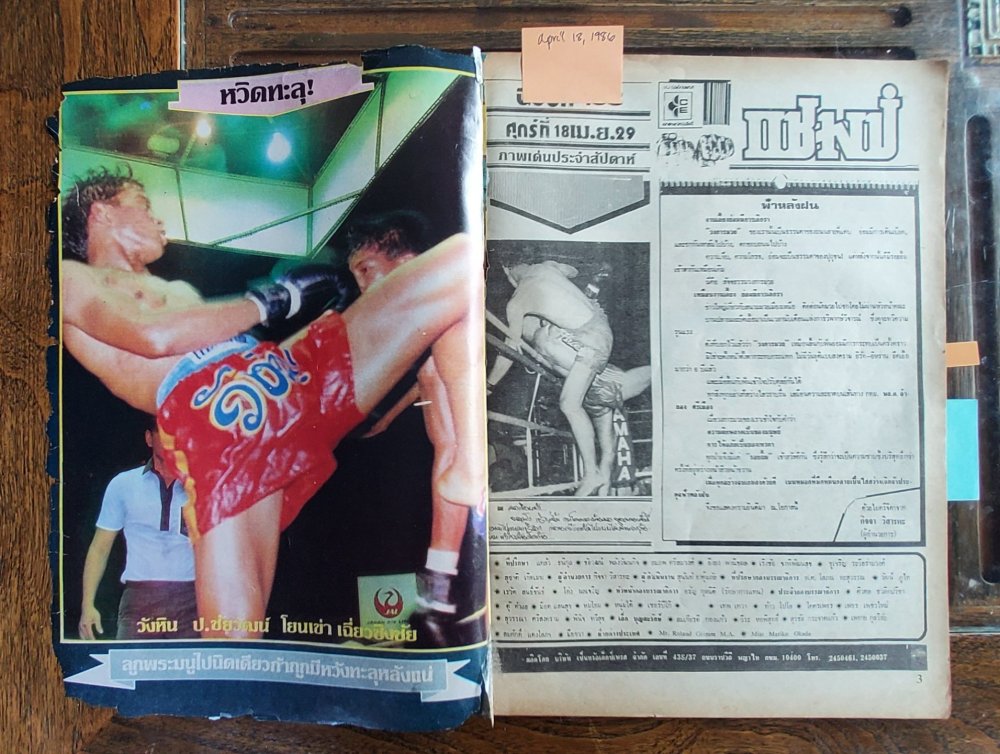
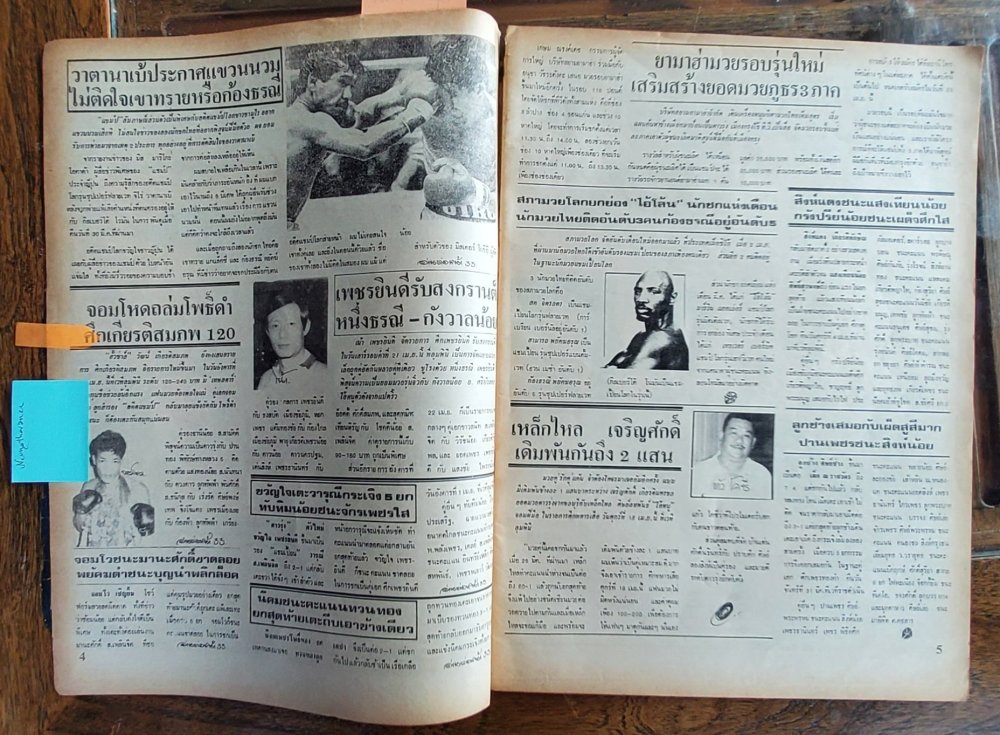

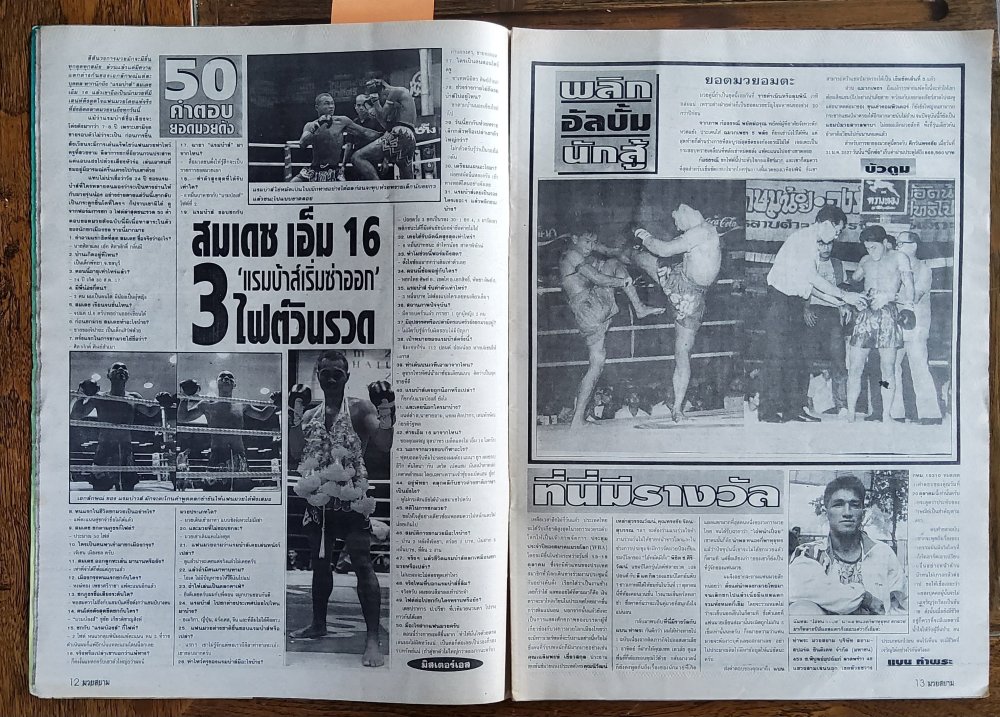
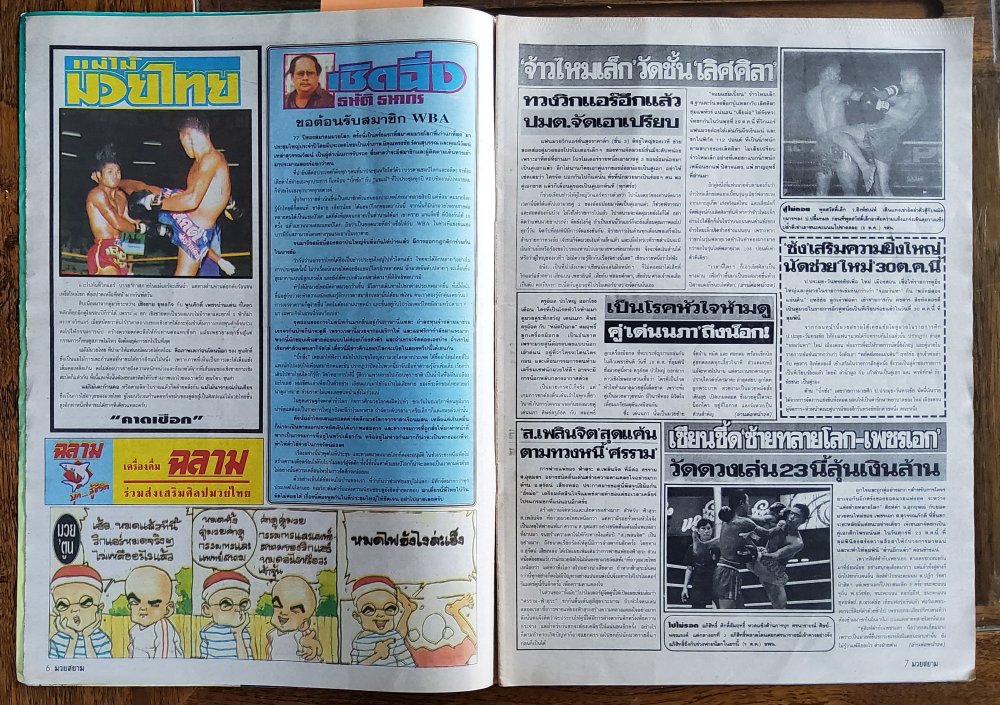

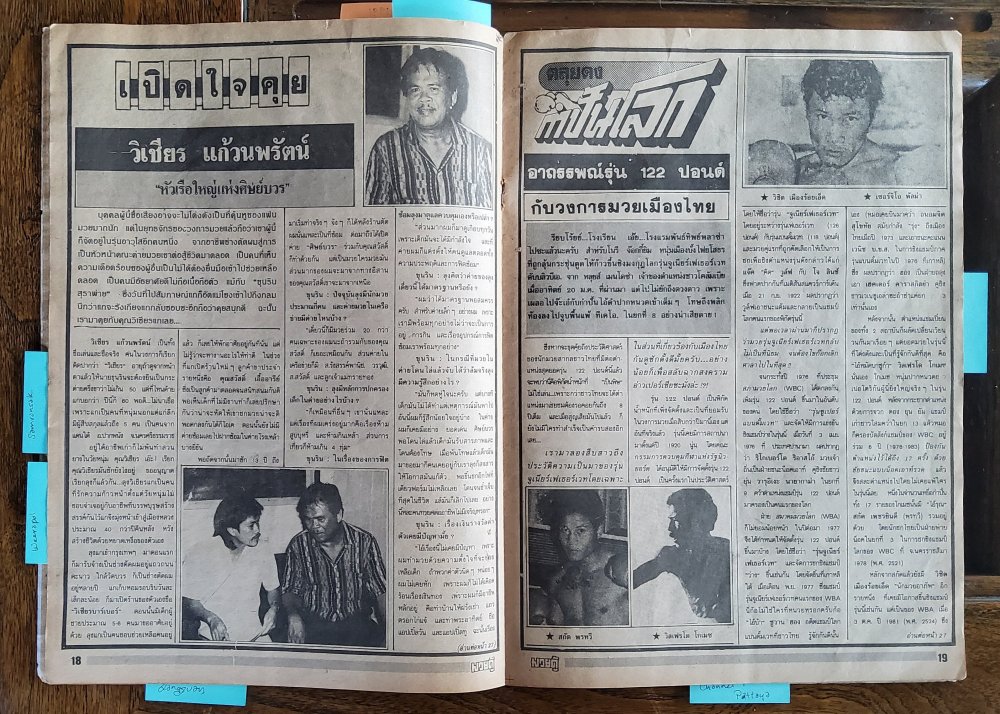
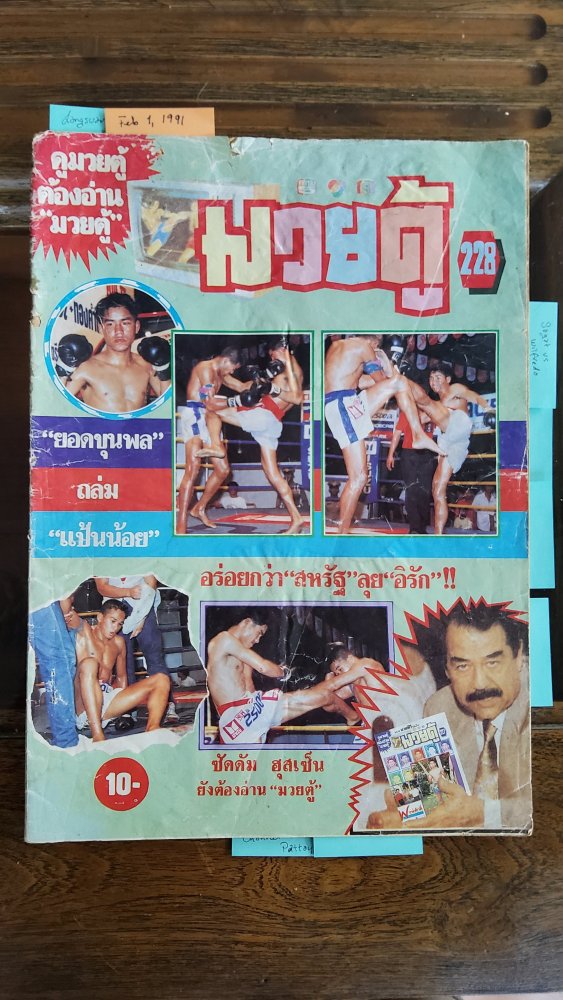
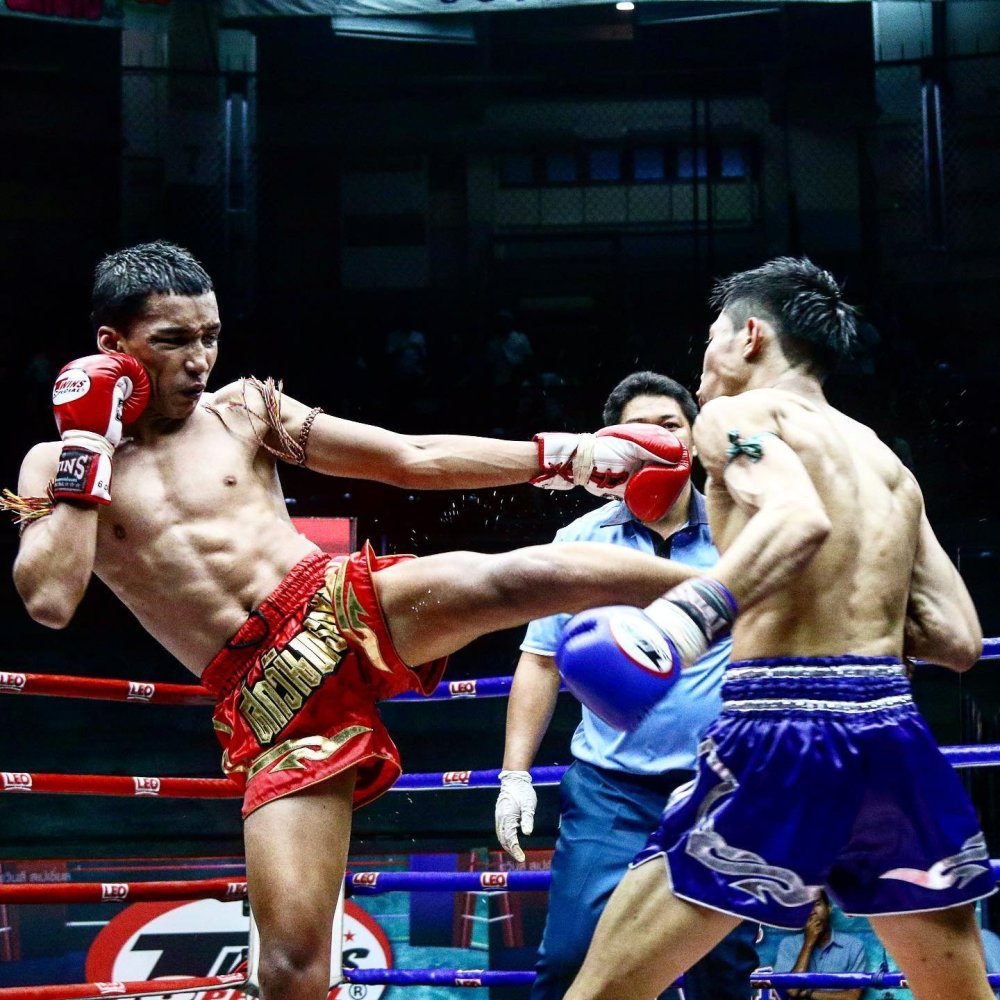
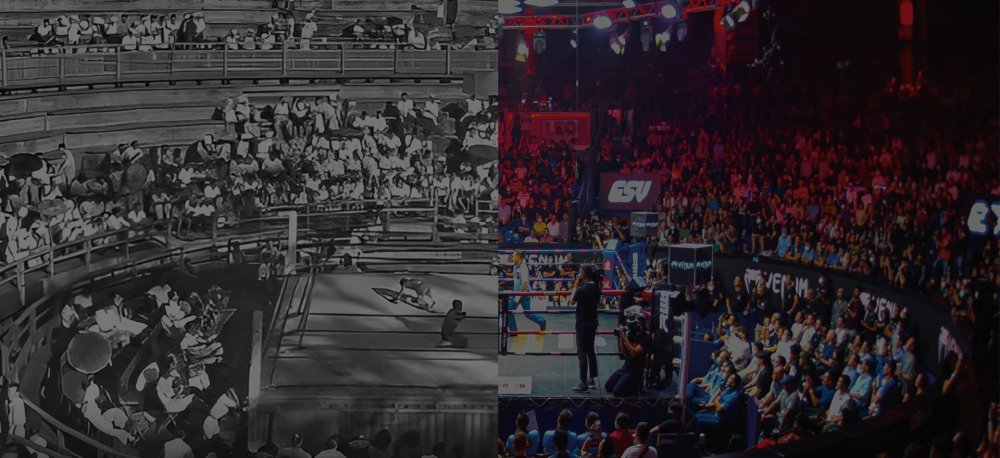
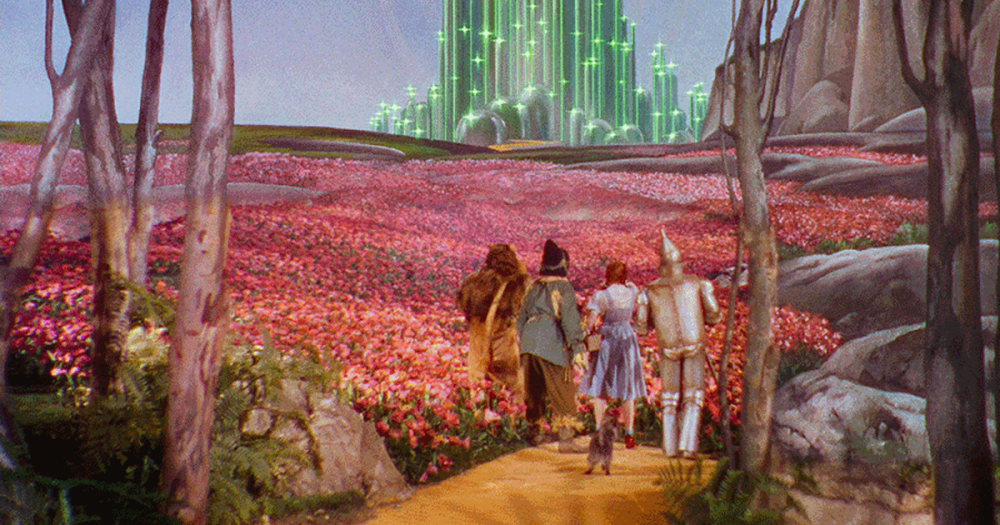
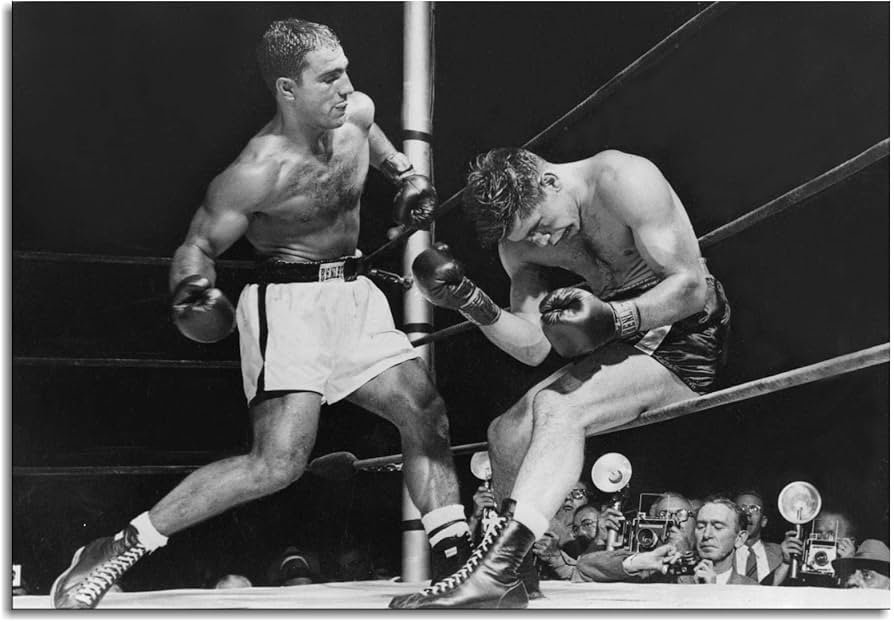
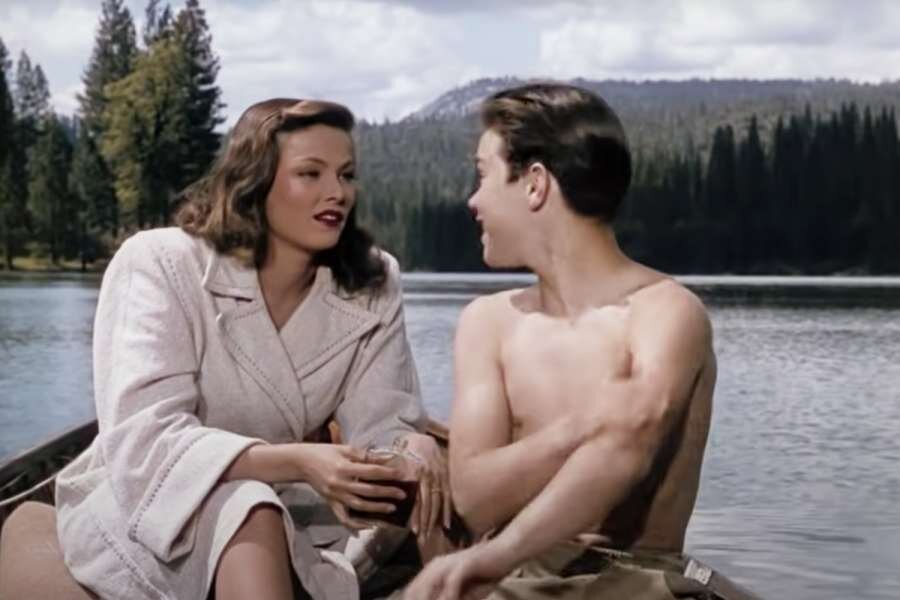
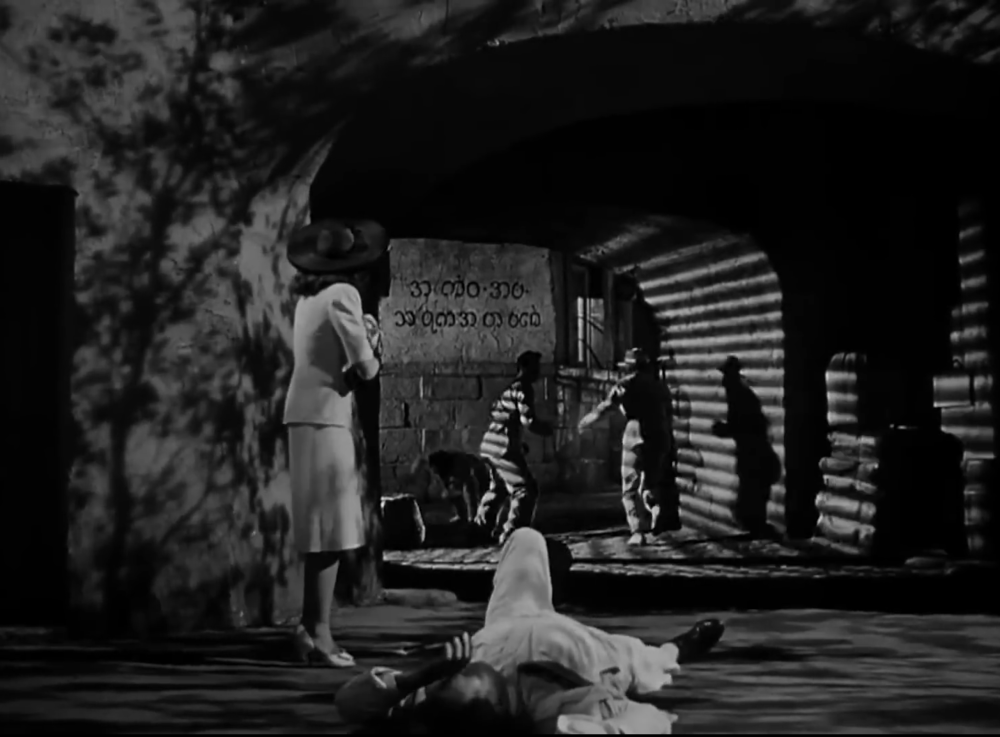
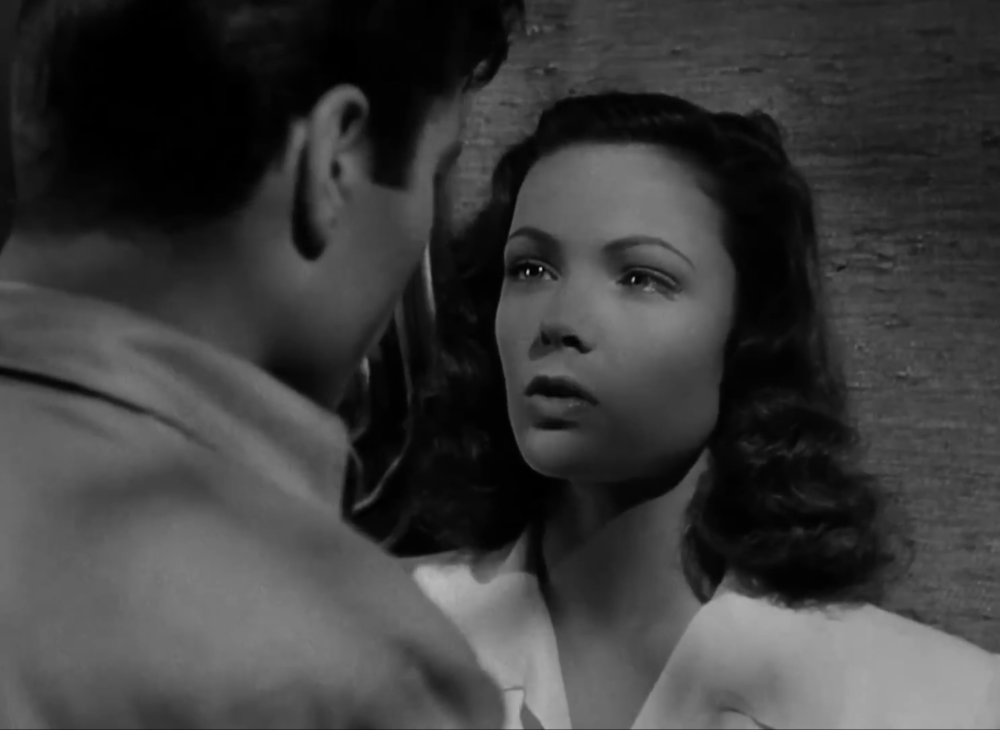




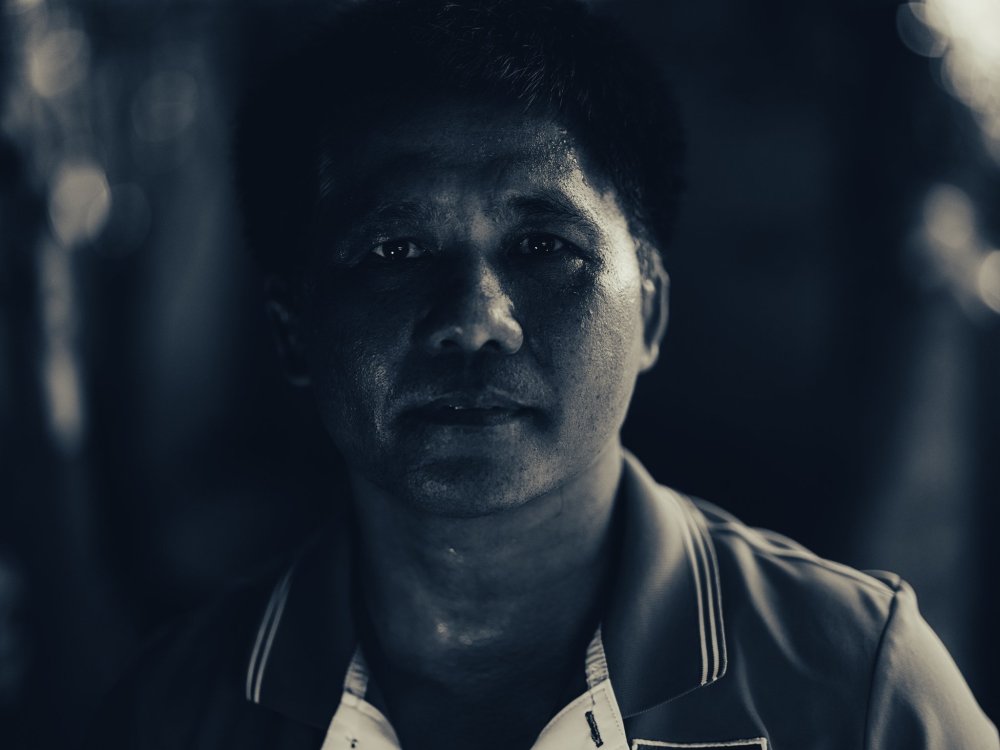
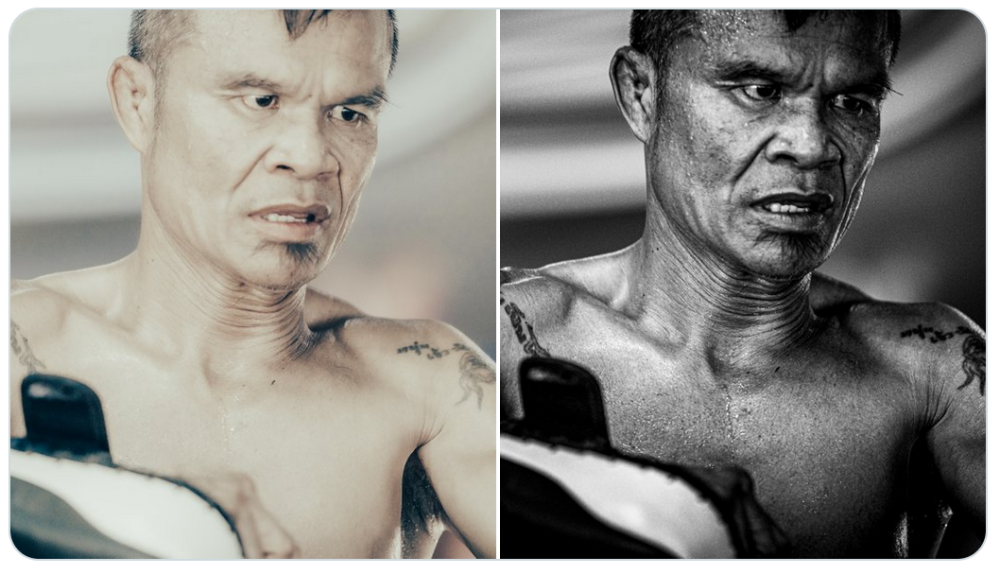
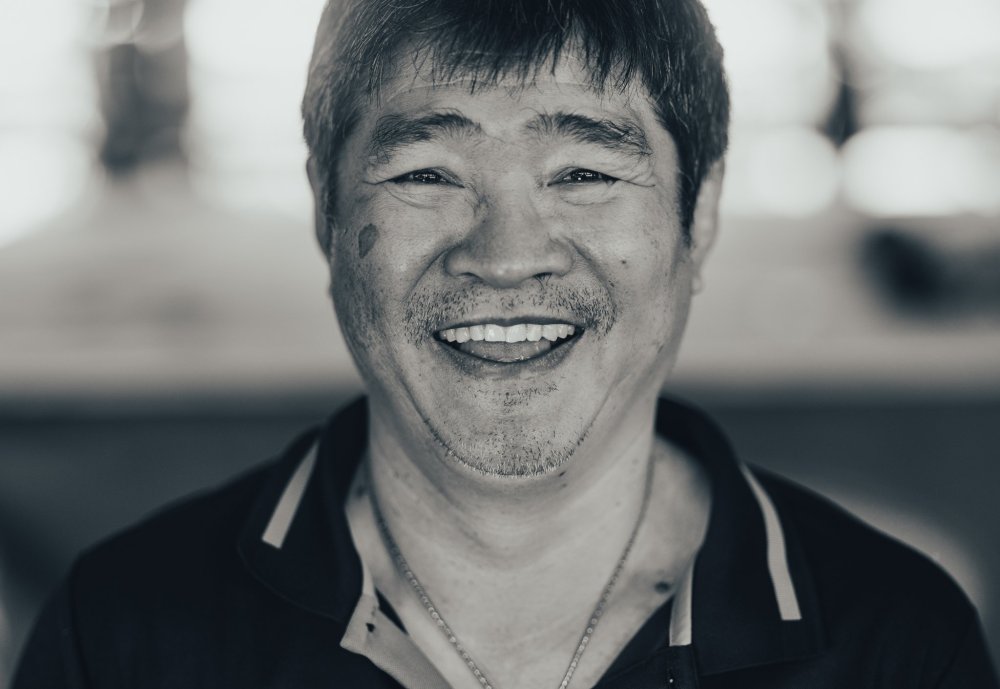
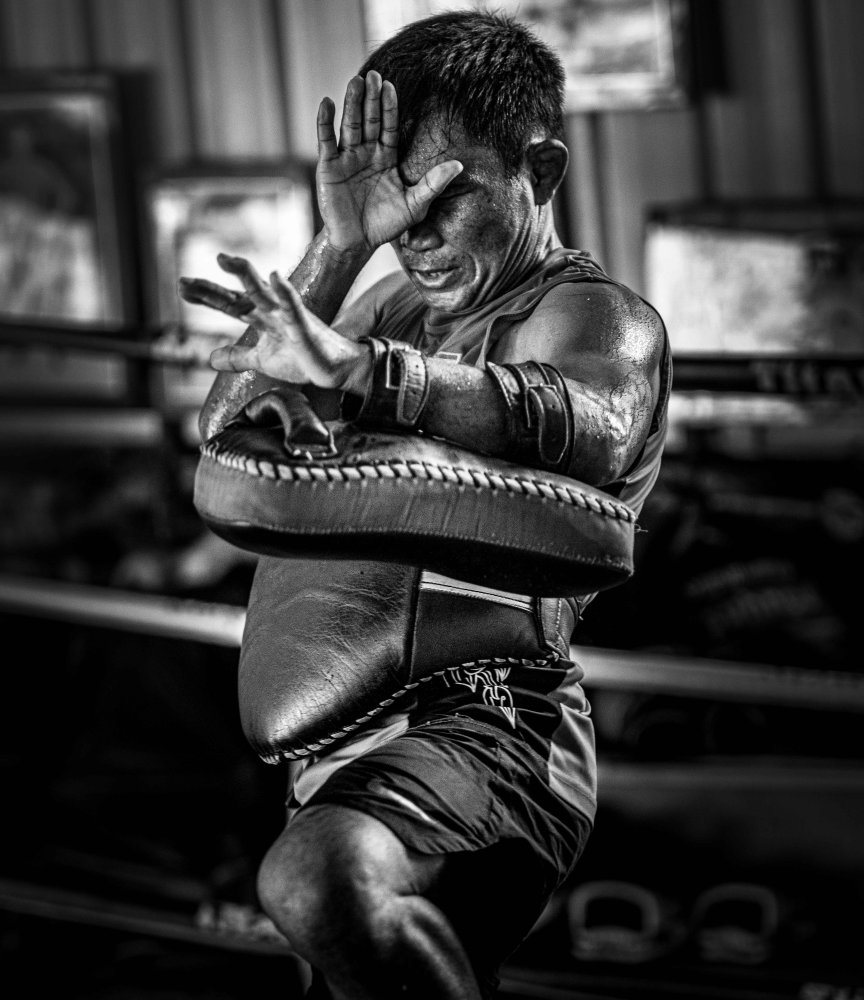
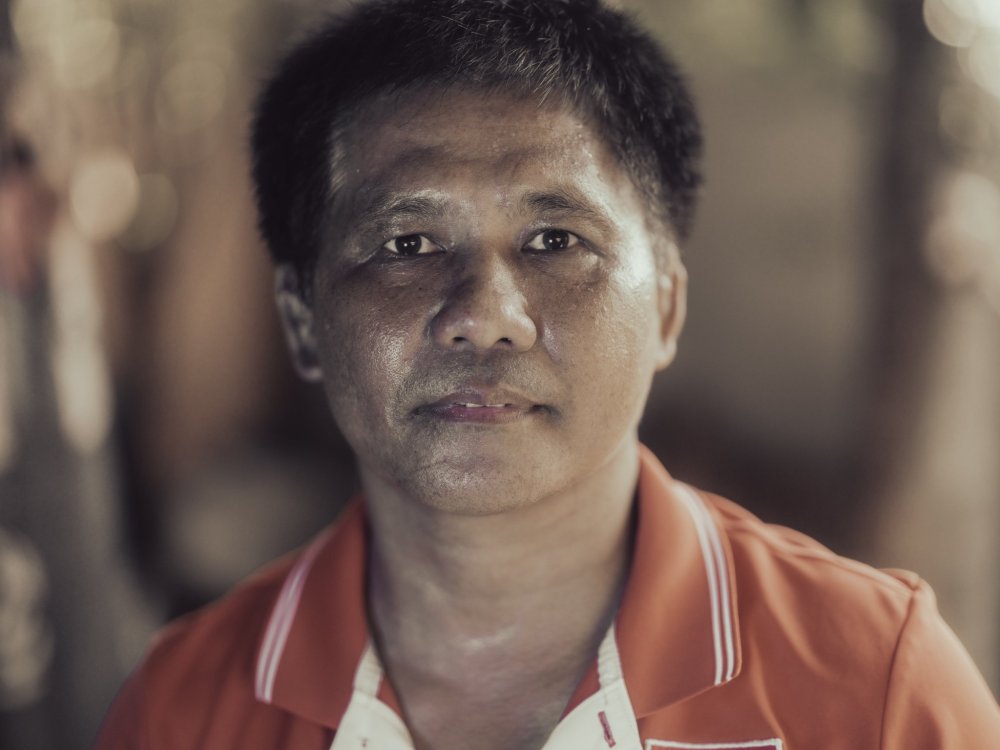
.thumb.png.7374e1779da38a2c58dd8d85b45b16dd.png)
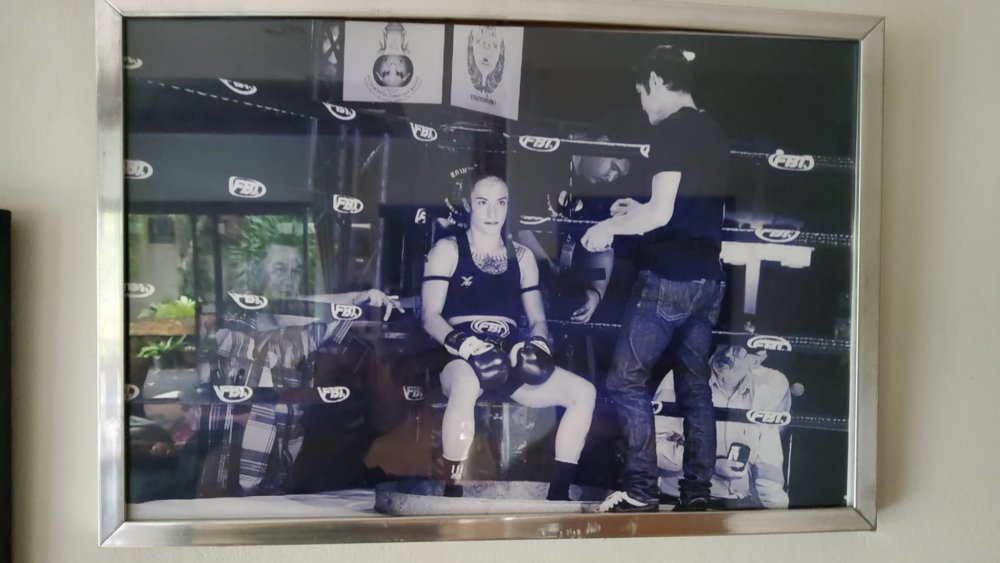
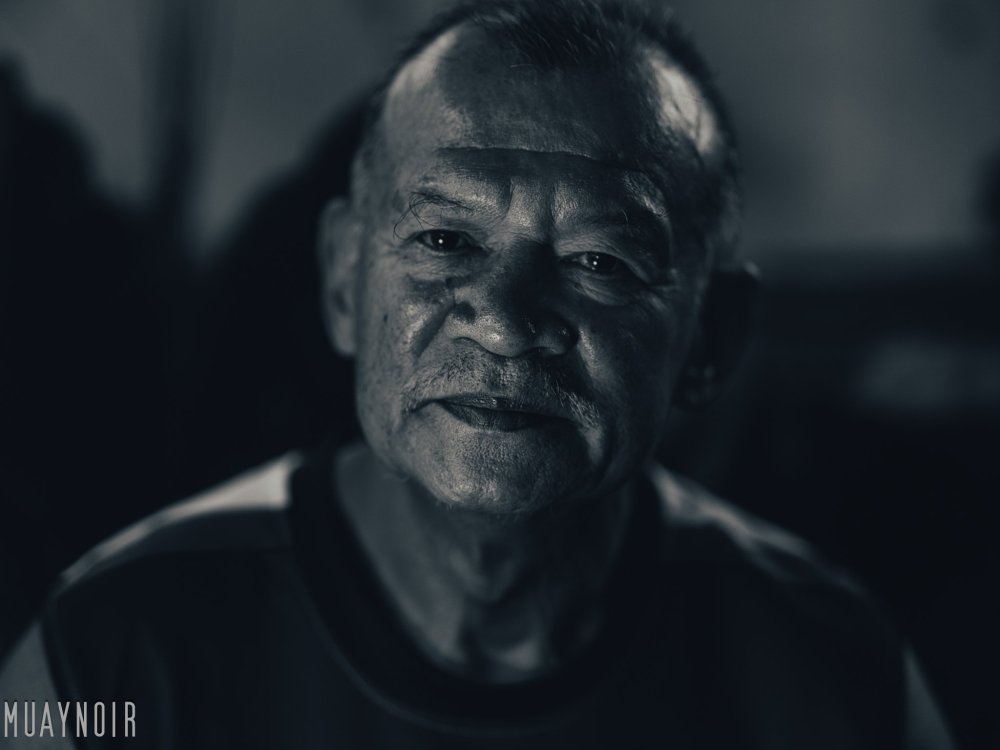


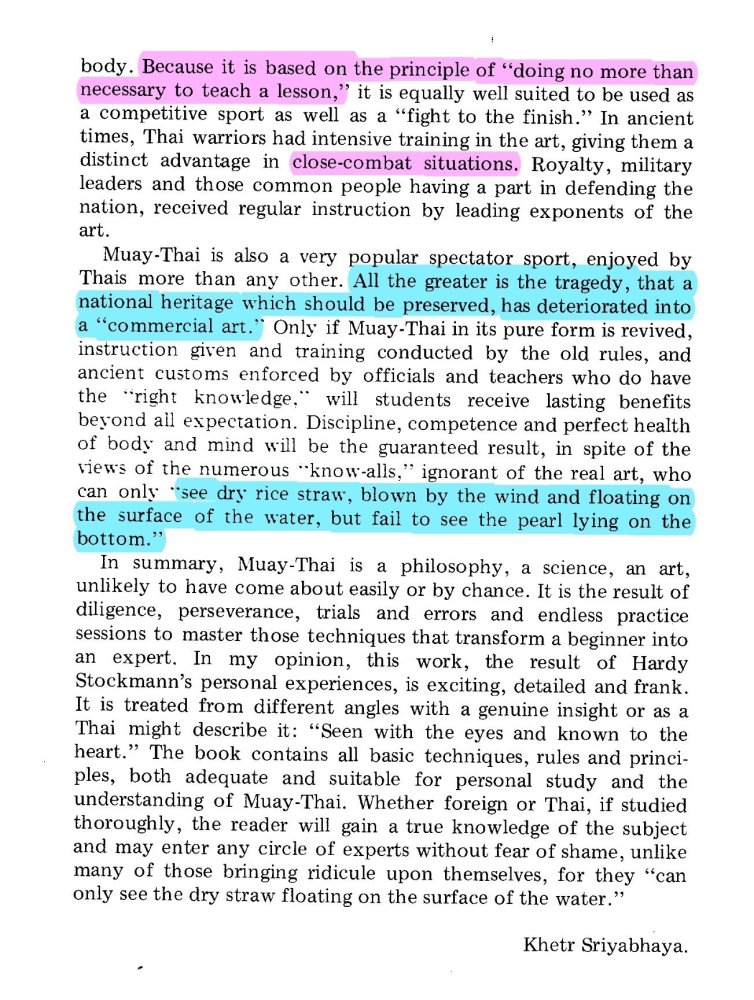
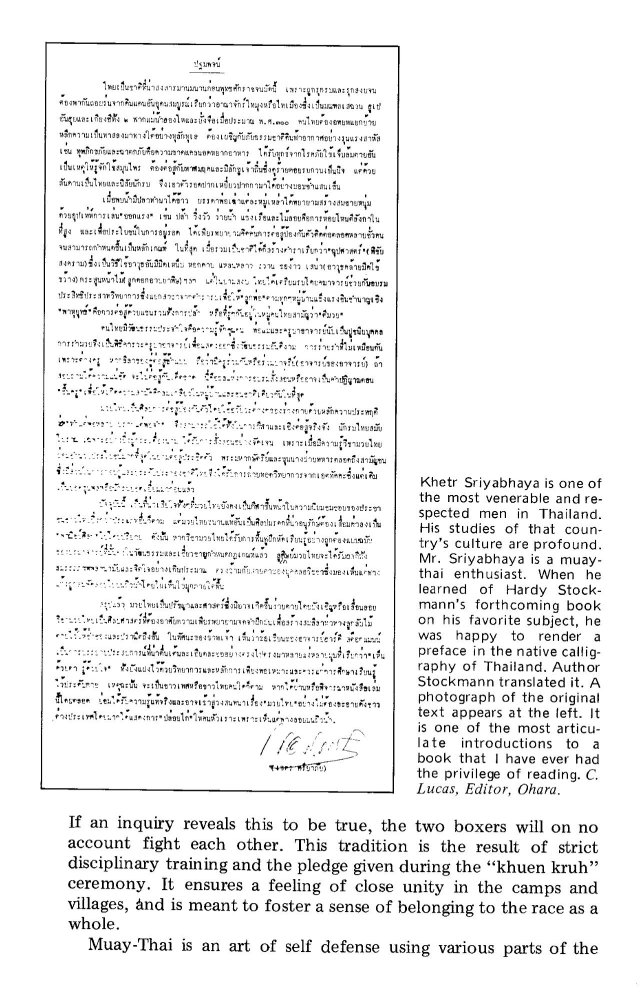

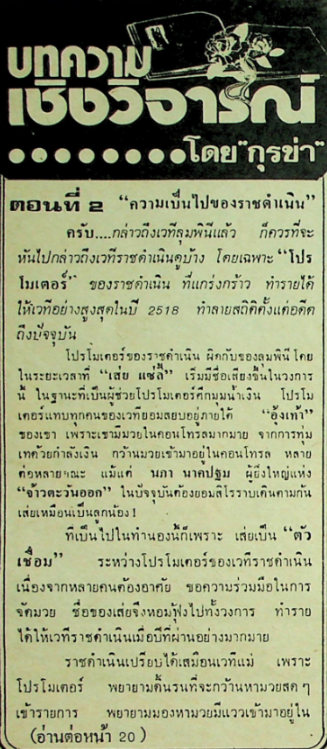
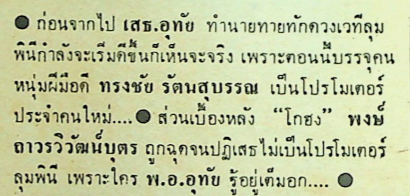
.thumb.jpg.66feff73ac2d19af5c00a84c2a245895.jpg)
-DieselnoiandWichannoi.thumb.jpg.f46e573262d242ecda77a44ba41d1390.jpg)
.thumb.jpg.f9912abc758d47f61585507d840a1ab1.jpg)
.thumb.jpg.5dbe4b5b9583a18bdc3633bc51191087.jpg)
.thumb.jpg.66743d9ccb3b1c7beed8f091d97a258b.jpg)
.thumb.jpg.faa241ef3acdafbeaffba177f058fb28.jpg)
.thumb.jpg.59ae034507d5bcb2ce1a362136d2a64c.jpg)
.thumb.jpg.33b3fa97beb608afb5b12e883196d0b8.jpg)
.thumb.jpg.bc675046512231cb48973349b6fa3f0a.jpg)
-WichannoiandAruchannoi.thumb.jpg.cbba210784ac8755b33489337e6cfc34.jpg)
.thumb.jpg.1914018a341a94617cdf44626929c3d6.jpg)
.thumb.jpg.66bee39d83474b57a516c42d9bee5c89.jpg)
.thumb.jpg.67f129379bdb1a2088e0d8a1113915f6.jpg)
.thumb.jpg.1eab7acabe43219cd41513eb739c584b.jpg)
.thumb.jpg.894649cad6df9b29b2c20304e4527bfd.jpg)
.thumb.jpg.620499810821e8b70d28d9ba3a1f867b.jpg)
.thumb.jpg.9cb04acc3ef5090ef1de07c4cfdb8d7c.jpg)
.thumb.jpg.5a861632726311ebcad5eb92bc5fea75.jpg)
.thumb.jpg.58ebfb417a3edc766abc0b9034a67744.jpg)
.thumb.jpg.f1defab7c95bb7248a323dc9e1c36524.jpg)
.thumb.jpg.4e9694564f157dfe59b8ccb21a007802.jpg)
.thumb.jpg.6acf308285b6d109b7a952db0634730f.jpg)
.thumb.jpg.272efed17dbab14c4598d1c4e1e3c958.jpg)
.thumb.jpg.e9c4ba3baa1cc049e4b1c4f674802b32.jpg)
.thumb.jpg.d7a270e4447e18e9a37c88c68c2dd58d.jpg)
.thumb.jpg.373c8ce93ad729d895957abb03f894e3.jpg)
.thumb.jpg.f42e310c70bc64771d203a140c9bfbf0.jpg)
.thumb.jpg.78f42f538954891f58ce386e34df156a.jpg)
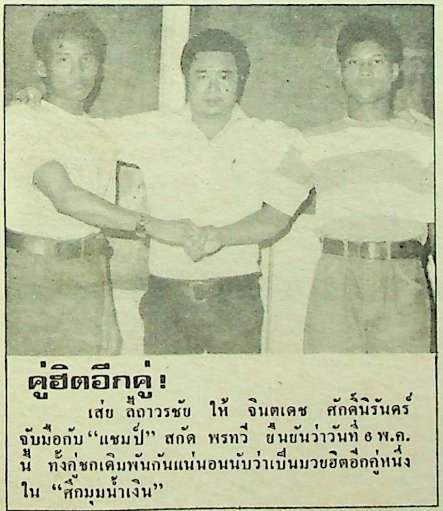
-MuayThaiLibraryProject(3).thumb.jpg.2ab6bdebce9dec16693ff32c4e1f9378.jpg)
-MuayThaiLibraryProject(4).thumb.jpg.c0ea28efb5e84a38d22ba76e3ea97df1.jpg)
-MuayThaiLibraryProject(5).thumb.jpg.7934536649a806f2e705daf6b5f74d67.jpg)
-MuayThaiLibraryProject(6).thumb.jpg.ba73db56bb046cbaf9b86dc2ea91e2be.jpg)
-MuayThaiLibraryProject(7).thumb.jpg.f777f80492c38d49340c0ae8d8442065.jpg)
-MuayThaiLibraryProject(8).thumb.jpg.ce68e61215411d01029e87f6a1f9b876.jpg)
-MuayThaiLibraryProject(9).thumb.jpg.12d402ce69b91099962a49085de7a821.jpg)
-MuayThaiLibraryProject(10).thumb.jpg.120f3908b76048d820913e68150c2de9.jpg)
-MuayThaiLibraryProject(1).thumb.jpg.b134e03a12ffe793a0861fa58b244564.jpg)
-MuayThaiLibraryProject(2).thumb.jpg.c54d0b48f8107283af9131214f619e72.jpg)
-MuayThaiLibraryProject(3).thumb.jpg.b3b539b42ea7850209b839bca34940f9.jpg)
-MuayThaiLibraryProject(4).thumb.jpg.152779029c6679faf0c6c46850b0fb57.jpg)
-MuayThaiLibraryProject(5).thumb.jpg.4ba7edd2035cc5dbaae4a707a53dc0bd.jpg)
-MuayThaiLibraryProject(6).thumb.jpg.a7c714491853cfb62ff6ff9efb8852ad.jpg)
-MuayThaiLibraryProject(7).thumb.jpg.422484b2e029f1822f878b9588d7e362.jpg)
-MuayThaiLibraryProject(8).thumb.jpg.a92f67c8b4175f7e1bc4b0b757fcd8c9.jpg)
-MuayThaiLibraryProject(9).thumb.jpg.2271e2b091f4e33c9a3ef194c0b3a4e2.jpg)
-MuayThaiLibraryProject(10).thumb.jpg.8123ff6ddfb51b72843269ac45778899.jpg)
-MuayThaiLibraryProject(11).thumb.jpg.4320ac569ac05ba25921ab3ae841a521.jpg)
-MuayThaiLibraryProject(12).thumb.jpg.01b33e8cdf56ca69199c4926f0550081.jpg)
.thumb.jpg.c24c015626d6e27303193dddf62c50f6.jpg)
.thumb.jpg.6c66a4cf1ae3a351ef96814b0e45368f.jpg)
PudpadnoiWichannoi.thumb.jpg.bbbb8c657b2dcd03447a1482c97d2604.jpg)
.thumb.jpg.b0ae5ed2b042148b4998e0f4de6da8ec.jpg)
.thumb.jpg.9b5fa8b246d258a879c3f5b3c283e8a6.jpg)
.thumb.jpg.ed7d1b19476b321ed90c19fa718fc883.jpg)
.thumb.jpg.c0f1d9b98eed049e3597f94ae8c899ca.jpg)
.thumb.jpg.6ce4464093e5ff27215e5e58b7395e1f.jpg)
.thumb.jpg.abf09edb7603d6bb52bf6207737fb3ec.jpg)
.thumb.jpg.26cca3fa5b2751a6afc83a1b75167713.jpg)
.thumb.jpg.b54eeefef5fd7ddde4983bb1ed00d8c2.jpg)
.thumb.jpg.cfd9d7026db511e8a2ea7ca1053528bb.jpg)
.thumb.jpg.950f37cf90dbc64dda7561aadfc20d11.jpg)
.thumb.jpg.a447bbad19db441a7e57131d46071c4f.jpg)
.thumb.jpg.dae37bd5254bc9238288a97f0504853e.jpg)
.thumb.jpg.55bf31b7d4cce72c7865398da1b55ccb.jpg)
.thumb.jpg.8c3d2a9c77dd71a4cea51abfdb5a0542.jpg)
.thumb.jpg.a039b3f014260cf72f8e6698f2b46ae1.jpg)
